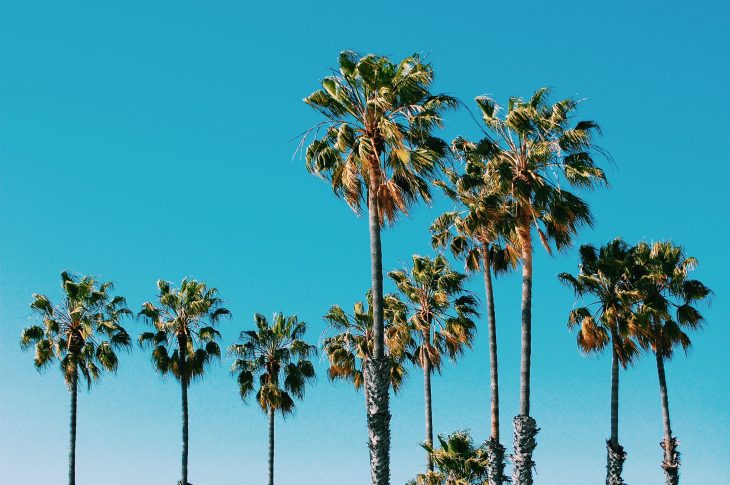
There are over 2,500 different types of palm trees around the world, and each of them comes from specific locations with the perfect weather climates that help them grow.
People prefer raising palm trees for different reasons. Homeowners purchase backyard palm trees because of their connection to the tropics, their resilience, and their beauty. Farmers, on the other hand, prefer raising them because of their production of acai berries, peaches, oil palms, dates, and coconuts. Most indigenous tribes use the entire palm tree for livelihood, making them a necessity for survival. All across the globe, spotted tribes use palm leaves for shelters and palm tree trunks for houses or boats. They also harvest palm tree fruits for nutrition.
But did you know that palm trees aren’t palm trees? Botanists have discovered that palm trees belong to the monocots family, which are a group of flowering plants. This makes the palm trees related to grass, corn, rice, and orchids. The reason why palm trees belong to the monocots family is because of how they grow. A palm tree trunk does not have any cambium rings, just like an actual tree does. This is because the trunk of a palm tree is a stem. Another reason is because of its root system, which uses shallow soil only and spreads around the palm tree to keep it steady, unlike deep-rooted trees.
You might be looking around the Web to search for a plant to take care of or you could be searching for the type of palm tree you recently came across. Either way, learning about palm trees is a great way to further appreciate them. Now, why don’t we start learning more about the types of palm trees around the world?
Origins of Palm Trees
To learn more about the types of palm trees, we should first understand their history. Archaeologists discovered fossil records of date palms in the Mediterranean territories. The earliest fossils date back 56 million years ago, during the Eocene epoch. Around this time, land animals became more dominant. This made the birth of palm trees a necessity for survival.
Archaeologists and botanists also discovered wild date palm tree seeds in Northern Iraq. They estimated the seeds of these wild date palm trees to be present 50,000 years ago. Assyrians, who once lived in the area, were preserving date palms for both religious and livelihood applications. We can see evidence of the Assyrians cultivating and pollinating the date palms on the monuments they left behind.
There were also numerous mentions of palm trees in the Bible. Christians and Hebrews use the palm tree as a symbol of peace, prosperity, and warm welcome. This is clear when the people waved palm trees upon Jesus’ entrance to Jerusalem. In contrast, the Romans preferred using palm trees as a symbol of victory and strength. An example of this ancient Roman practice is lawyers putting palm trees on their doors whenever they win a case.
There are still ongoing religious practices involving palm trees. However, palm trees are currently more used for the production of syrup, jewelry, furniture, fuel, medicine, and more.
Types of Palm Trees By Region
It’s time to learn about the different types of palm trees now that we know so much about their history. Unfortunately, we cannot present to you all 2,500 types of palms without turning this into a lengthy discussion. Here instead is a shortlist of a few palm trees including facts and uses of each.
Types of Palm Trees in America
America has a wide area suitable for different types of palm trees, notably ones from Florida, California, Arizona, Colombia, and Mexico.
Sabal Palm
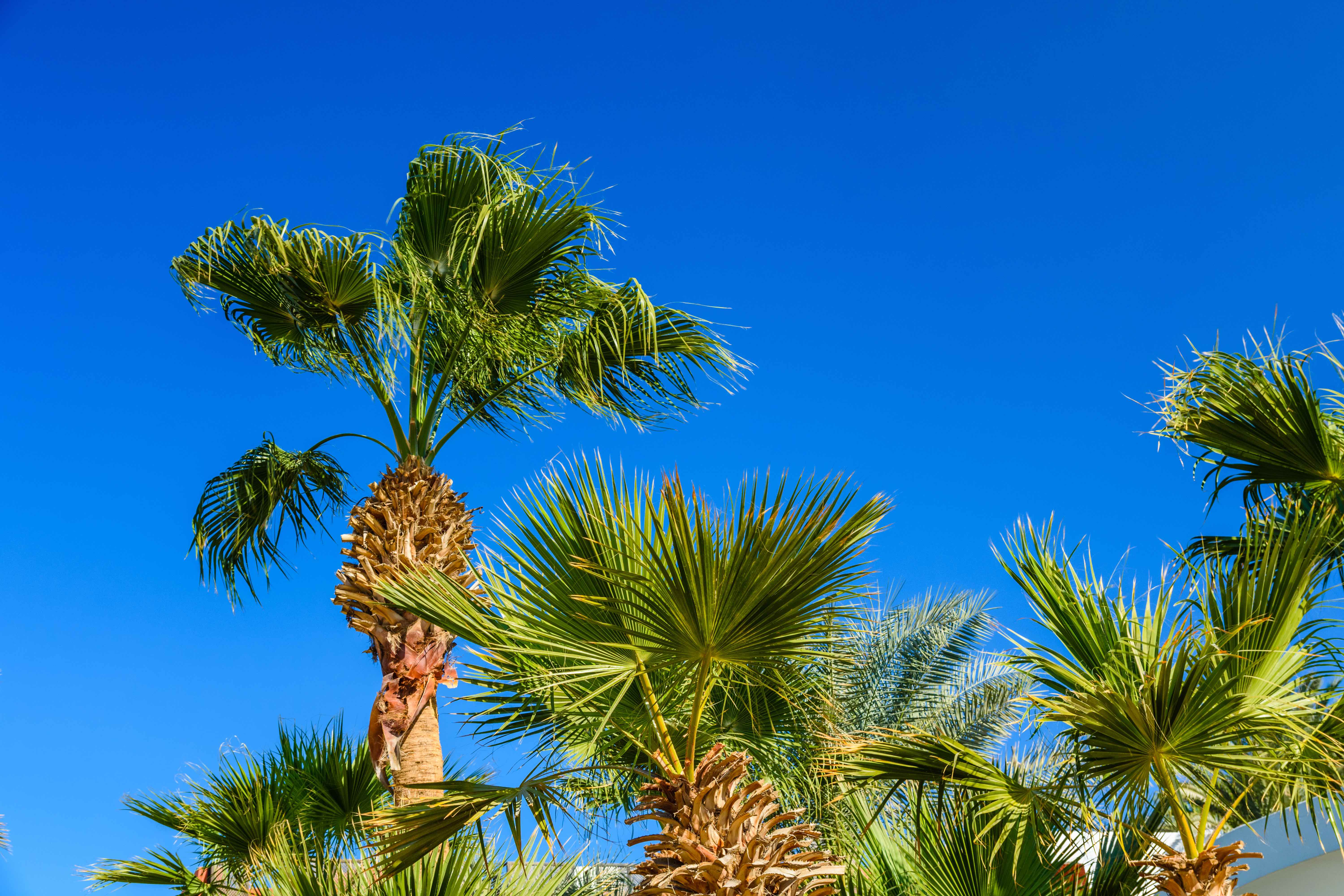
The first one on our list is the sabal palm tree, which is the state tree of Florida. Palm trees such as the sabal palm are low maintenance, simple to grow, transferable, and have high resistance to hurricanes, floods, and fires. The sabal palm’s durability allows it to grow just about anywhere. As a result, other native Florida palm trees cannot compete with its overwhelming popularity
The sabal palm goes by many names: the cabbage palm, sabal palmetto, blue palmetto, Garfield’s tree, common palmetto, cabbage palmetto, and the swamp cabbage. Sabal palms are one of the 15 species of palmetto palms. You can also find them existing on the Lower East Coast and other Southern parts of the United States.
Sabal palms can grow up to 65 feet and produce costa palmate fans. You can harvest the sabal palms’ fruits which are black drupes that taste sweet. The sabal palm tree is tolerant of saltwater and wind, just like the other types of palm trees in Florida. Unfortunately, the sabal palm is not resistant to saltwater flooding.
Native Americans were the first to harvest the sabal palm’s terminal bud. They consumed it in a similar way you would a heart of cabbage or an artichoke. Because of this, chefs began using sabal palms to make a heart of palm salad. You can also use the young leaves of the sabal palm to make brushes and their logs to make wharf piles.
Roystonea Regia
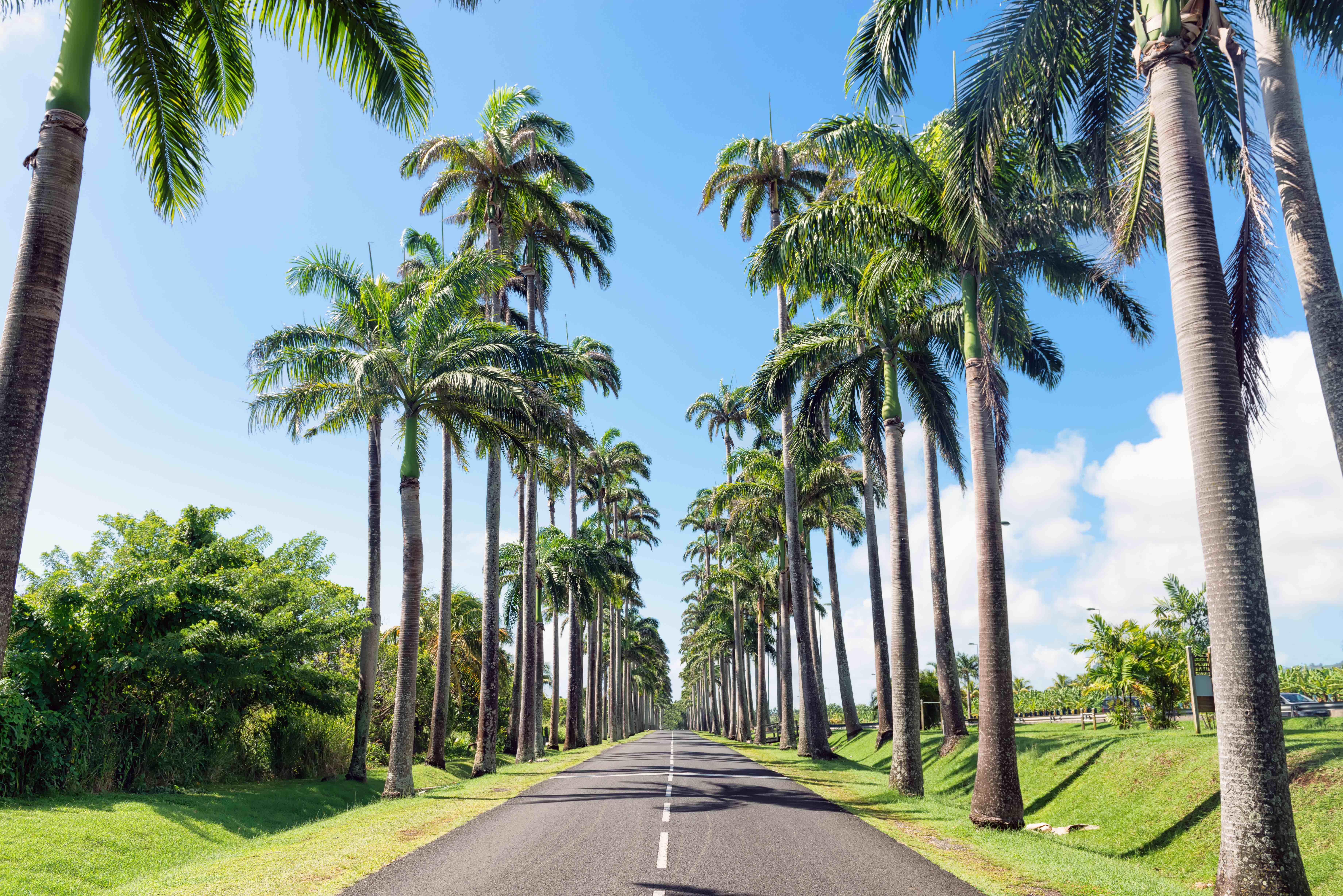
Another one of the types of palm trees native to Florida is the Roystonea regia. An interesting fact in the history of the Roystonea regia is that scientists once split into two species: the Cuban royal palm and the Florida royal palm. Thanks to the combining of the two species, there are now only three types of royal palms in the world.
The Roystonea regia isn’t just native to Florida. You can find these royal palm trees in Central America, Mexico, and the Caribbean. However, it’s also important to note that people commonly use the Roystonea regia as an ornamental tree. This results in them being planted nearly everywhere there is a tropical climate.
The Roystonea regia can live at a maximum of 150 years. They can also reach up to a maximum of 113 feet. Roystonea regia palms have smooth grey-white trunks with a bulge separated by a unique green crownshaft. These palm trees can also produce white or pink flowers and edible dates.
There are a few more facts about the Roystonea regia worth noting. Cuba has declared the Roystonea regia as their national tree, this is because of their participation in Cuban religions. Santeria, one of the prevalent religions of Cuba, associates the Cuban royal palm to Aggayu (Orisha of the Volcano) and Shango (Orisha of Weather and Thunder), an important figure in their faith. Roman Catholicism, another religious practice in Cuba, uses the royal palm during Palm Sunday, an event that mimics Jesus’ arrival in Jerusalem.
The California Fan Palms
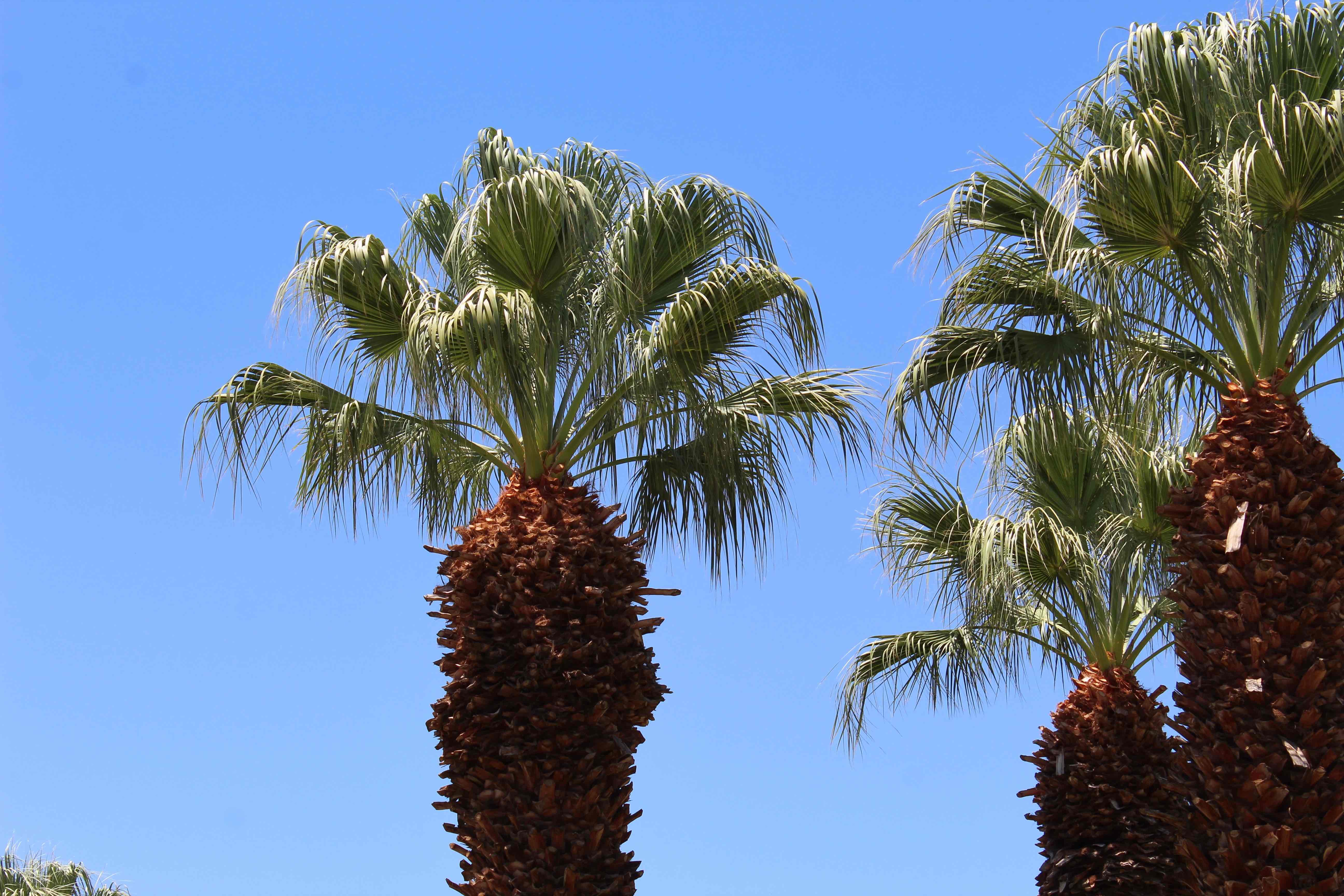
The California Fan is the most famous among the types of palm trees in California, Baja. You can call them the desert fan palm, the Washingtonia filifera, and the California palm. These palm trees are native only in the free state of Mexico and in the southwestern part of the United States.
The California fan palm reaches a maximum height of 66 feet and 20 feet broad. Its leaves are waxy and fan-shaped, hence the name. They also have a distinctive skirt made up of the dead fronds that hang on them. You can find wild California fan palms in the desert as they thrive on moderately alkaline soil with dry climates. However, they are also an ideal choice of Californian gardens. California fan palms are also adaptable to temperature. The palm trees can withstand heat waves during the summer and the freezing temperatures of winter. This results in imports of the desert fan palm to other locations with similar weather.
There are three ways the California fan palm aids in the survival of different wildlife in the desert. Firstly, the hooded orioles use the leaf fibers of the fan palm to make their nests. Secondly, canyon tree frogs, Pacific chorus frogs, Baja ratsnakes, and western yellow bats all use the fan palm for shelter. And thirdly, coyotes harvest the ripened fruits of the fan palm during winter. In return, the coyotes become important seed distributors throughout the area.
Needle Palmetto
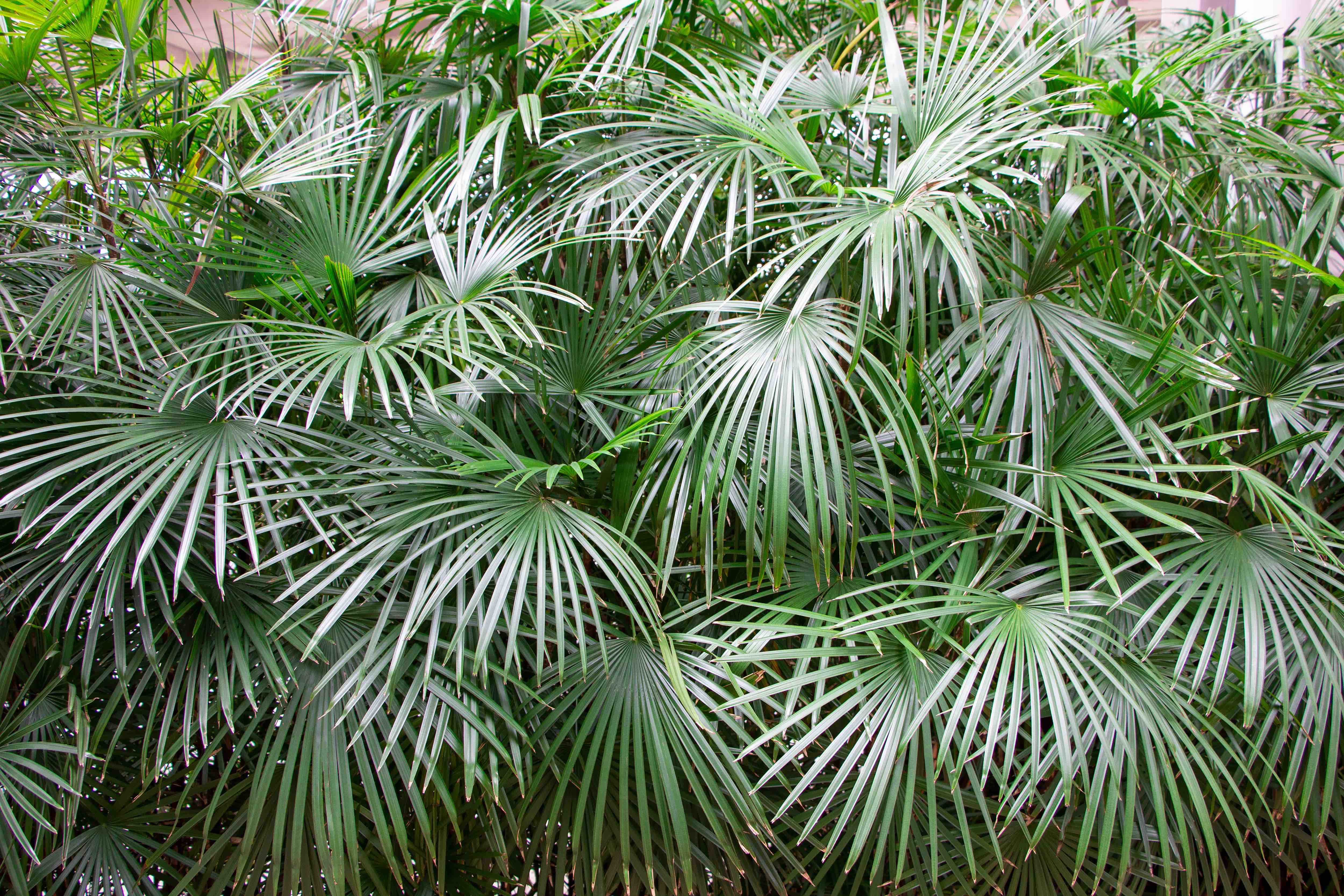
The Needle Palmetto starts off as a spiky palm plant and grows up to 3 to 10 feet long. Botanists agree that the needle palmetto is one of the toughest palm trees in the world because of its clumpy form and needle-sharp leaves. Needle Palmettos naturally grow in Alabama, Florida, South Carolina, and Mississippi. An adult needle palm can withstand a temperature of -5 degrees Fahrenheit.
Most people from Charleston, Kiawa, and Mount Pleasant prefer growing the Needle Palmetto since the natural climate of the area allows the palm tree to grow with low maintenance. Needle Palmettos are weak against saltwater. As a result, areas near the ocean rarely have these types of palm trees.
Many people buy the Needle Palmetto for their home because it is a cold-hardy palm tree with a beautiful form and requires little to no maintenance. Unfortunately, this has caused an increase in demand for the Needle Palmetto. Cultivation of the palm tree can be seen in areas such as Washington, Chesapeake Bay, and Tennessee. While they may still be thriving thanks to these environments, the wild Needle Palmettos are endangered. When buying a Needle Palmetto, it is important to note if the seller is authorized to do so. This is because some people illegally harvest wild Needle Palmettos from their own area.
Quindio Wax Palms

Have you ever wondered how tall do palm trees grow? The wax palm trees of Colombia are the tallest palm trees in the world. Before the discovery of California’s sequoia trees, the Quindio wax palms were thought to be the tallest trees on earth. Quindio wax palms can stand up to 200 feet and are coated in wax. Botanists and explorers have been fascinated by the wax palms because of their ability to thrive on the peaks of the Andes mountain (10,000 feet above sea level). Colombia eventually declared the wax palms as the country’s national tree in 1985 because of their dominance in the area despite their rarity.
The Tochecito region, a place filled with endangered wax palms, was once restricted due to the FARC (Revolutionary Armed Forces of Columbia) who kidnapped foreigners and were dangerous to locals. After they left the area, the Tochecito region was now accessible, making it easy for botanists, researchers, and explorers to visit the palm trees. Before the FARC’s departure, the last time anyone peacefully saw these wax trees was Alexander Von Humboldt, a 19th-century German explorer that described the view as “a forest above a forest.”
By the time the Tochecito became accessible, progress on the wax palm’s genus and history research grew exponentially. Dr. Sanin, a botanist and specialist on the wax palm genus, discovered that the wax palm trees developed their resistance to cold climates 12 million years ago when the Andes mountain began rising. Dr. Bernal, a partner of Dr. Sanin, spent his lifetime researching the wax palms. In his study, he discovered that the Quindio wax palms in the Tochecito region have the ability to switch sexes. This ability is extremely rare in all parts of nature.
Types of Palm Trees in Africa
You can find different types of palm trees in Africa. The continent’s wildlife and ecosystem are suitable living conditions for palm trees. This is because the wildlife and the Africans themselves rely on palm trees for livelihood.
African Oil Palm
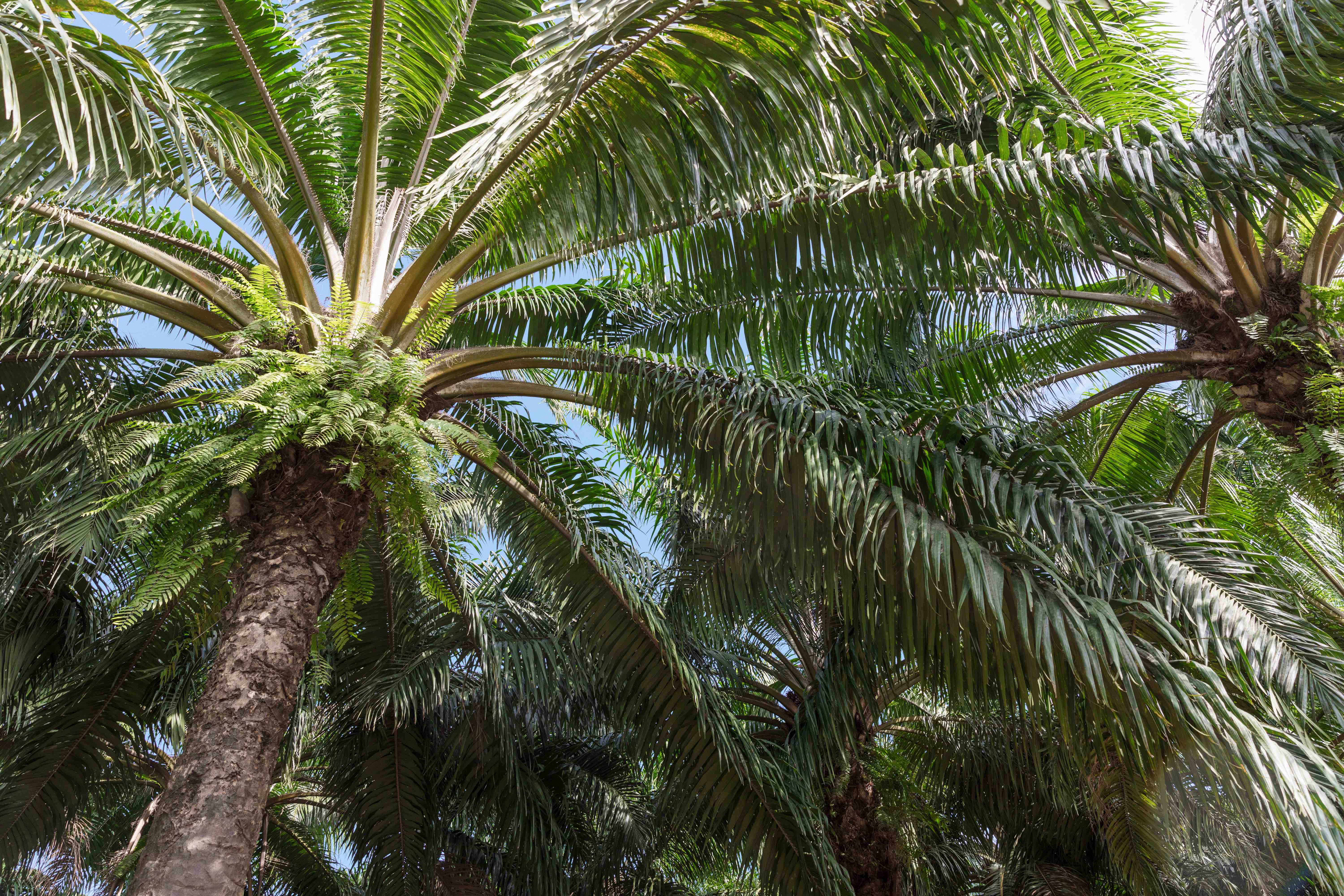
First on our list of the types of palm trees in Africa is the oil palm tree. The African oil palm has one large stem and can reach a maximum height of 66 feet. They are known to sprout clusters of tiny flowers on their short branches. These flowers eventually form into a group of oval fruits. When these fruits ripen, they become black with a red base and contain only one oily seed called the kernel.
African oil palms are one of the most heavily cultivated palm trees in the world. Human food consumption uses large quantities of palm oil. Factories also require palm oil to create cleaning products, makeup, and skincare products. There are also medical treatments for vitamin A deficiency centered on palm oil as the main ingredient. Currently, manufacturers and scientists are attempting to create biofuels with the use of palm oil as well.
The increase in demand for palm oil created an aftereffect that resulted in many cultivation areas for oil palm trees. Corporations scatter plantations of the oil palms across tropical areas where the palm tree can survive. Unfortunately, some areas have been affected because of the creation of these plantations. There are reports of African oil palms becoming invasive in Micronesian islands, Bahia, and Brazil, resulting in a change in the natural ecosystem of the area. There are also accounts of deforestation to make way for the plantations, which also damages the wildlife in the particular area.
Hurricane Palm
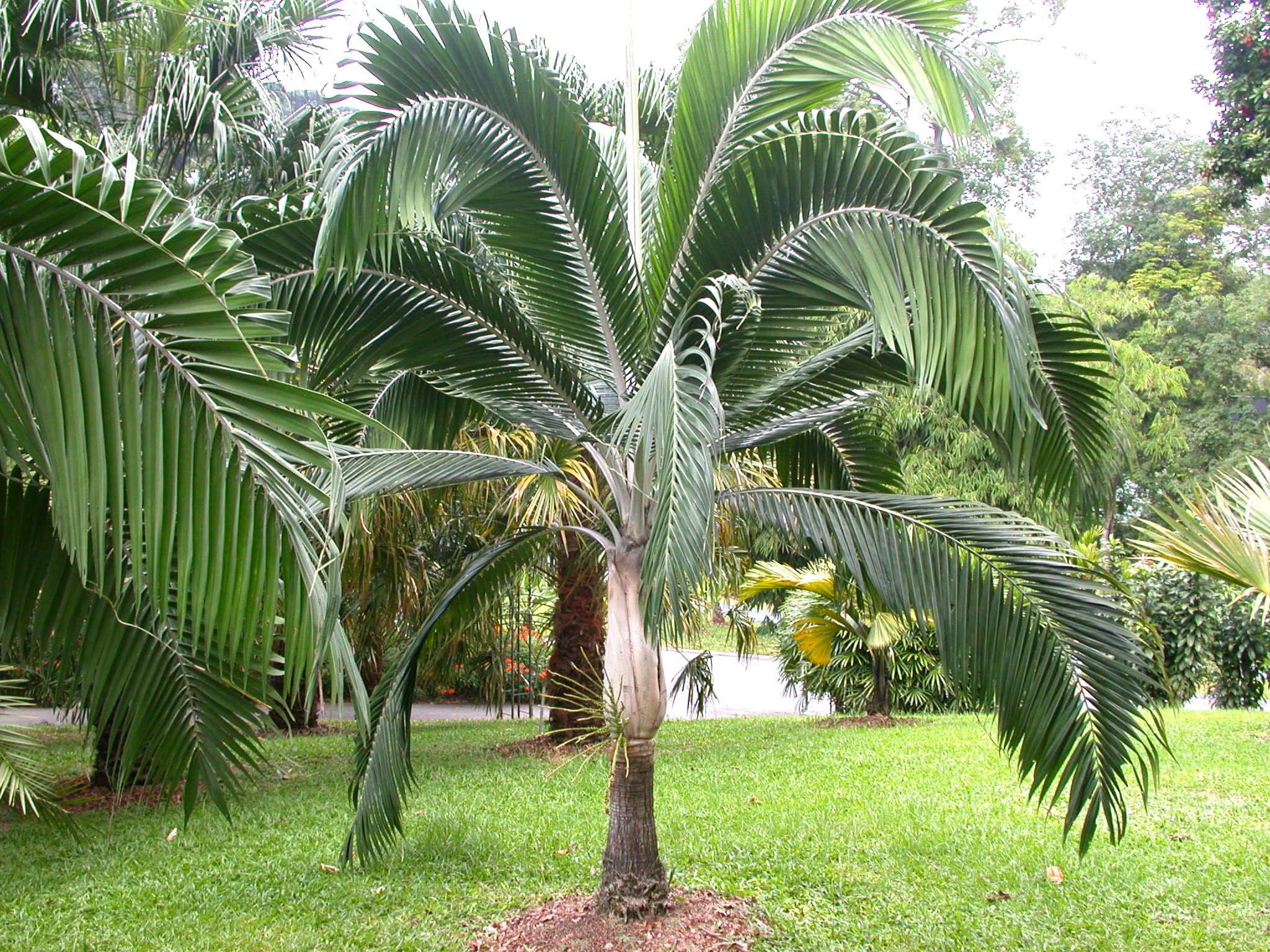
The hurricane palm, also known as the princess palm, is a type of flowering palm tree with extreme resistance to strong winds. These palm trees have solitary ringed trunks and a bulge at the base. Its crownshaft is 3 feet tall, swollen, and covered with white wax. The hurricane palm produces dark green leaves that arch and point towards its peak.
An interesting fact about the hurricane palm trees is their six inflorescences that have male or female genes. All you would have to do to identify what gender the flowers are is to check whether they are white (male) or yellow (female).
Hurricane palm trees also produce ovoid fruits. These fruits become black or purple when ripened and contain only one brown seed with an ovoid shape.
You can find the hurricane palm tree naturally in the coastal forests of the Mascarenes islands. They prefer tropical climates, constant rainfall, and humidity. Hurricane palm trees are popular ornamental trees because of their resistance to tropical storms and hurricanes. This results in seaside cities and establishments purchasing hurricane palm trees. While they remain cultivated because of the increase in demand, hurricane palm trees are nearing extinction in their natural habitat.
If you wish to purchase a hurricane palm tree, it is important to check whether the seller received the plant through legal ways.
Lodoicea Maldivica
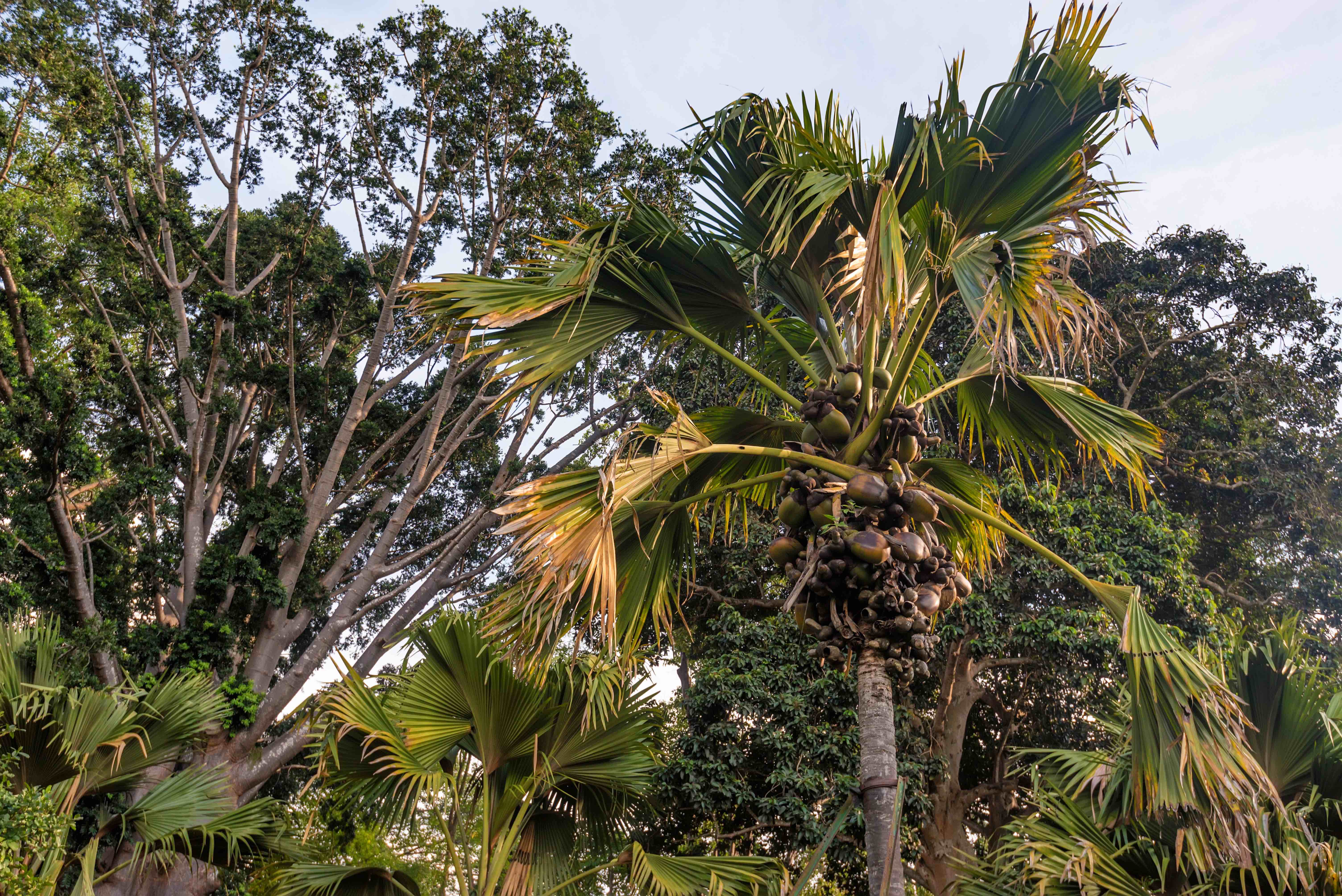
Africa’s types of palm trees also include the largest seed in the world. Lodoicea Maldivica, also known as the coco-de-mer or the double coconut palm, is native only to the Praslin and Curieuse Islands in the Seychelle nation near Somalia. These palm trees can reach over 110 feet with gray trunks and fan-shaped fronds. Coco-de-mer can produce male and female flowers, making them dioecious.
Coco-de-mer palm trees are the most expensive palm trees you could buy. You can purchase these palm trees at a maximum of $9,000, depending on their size. This is because the coco-de-mer palm tree holds four notable records for plant life.
Coco-de-mer’s male flowers are the longest male flowers in the world. These flowers look similar to catskins but reach up to a meter long. Its leaves are also the longest of any flowering plant, reaching six meters. Botanists have also discovered that the lifespan of these leaves can reach 50 years.
The palm tree also holds the heaviest nut with a record of 42 kilograms. However, the seed takes two years to germinate for it to achieve such weight.
Coco-de-mer also holds the record for the largest nut in the world. Its coconuts can reach a maximum of 50 centimeters in diameter. Although, just like its seed, the fruit takes six to 10 years to ripen.
The wildlife in Seychelles, such as the Seychelles bulbul and the Seychelles black parrot, depend on the coco-de-mer for shelter and food. Natives of the island also use the palm tree leaves to create household materials and hollow the seeds to create liquid containers. Unfortunately, some people believe the coco-de-mer’s seed is a strong aphrodisiac. This has resulted in illegal trades and poaching of these palm trees.
Blue Latan Palm
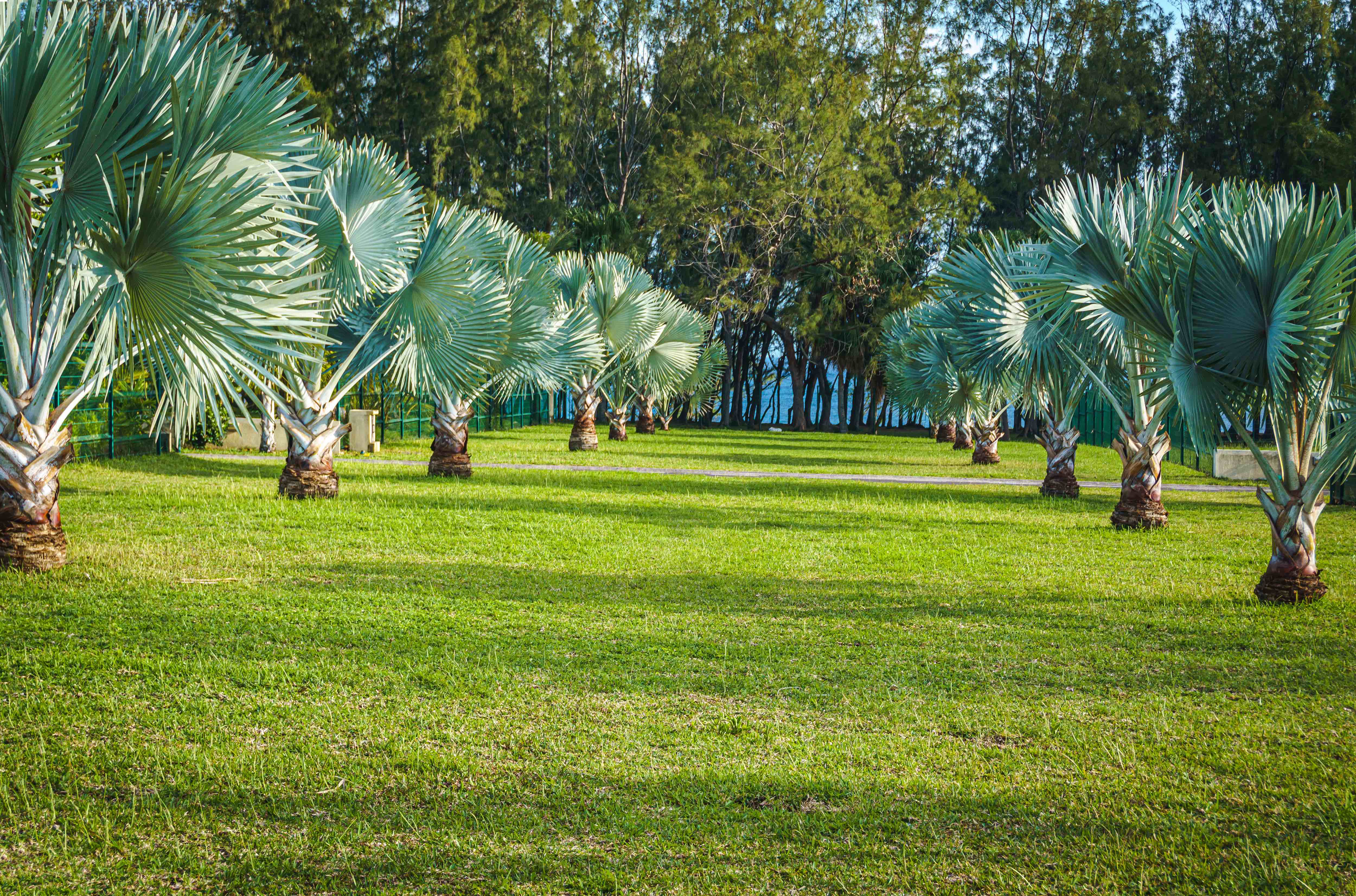
Next on our list of the types of palm trees is the blue latan palm. This palm tree is native to the Mauritius Island of Africa. Also known as the Latania loddigesli, the blue latan palm has evergreen silvery-blue leaves with a pale gray trunk reaching 10 inches wide. These leaves are 8 feet wide and placed together by five-foot-long petioles. Woolly tomentum creates a silver coat for the palm leaves, giving a silvery appearance.
Blue latan palms can reach a maximum height of 25 feet and are at least 10 feet wide. They prefer sunny weather and can withstand drought. Pruning a blue latan palm is only required when there are diseased or dying fronds. Unfortunately, no amount of pruning can produce more leaves. This is because the palm leaves naturally regrow in-between seasons.
Many people prefer blue latan palms because of their beautiful appearance. They are also adaptable despite their slow growth. Blue latan palms prefer sunny and dry climates. This is because they are sensitive to temperatures below 32 degrees Fahrenheit. Blue latan palms are preferred as ornamental designs. Seaside cities use them to decorate driveways because of their moderate tolerance to salt. Unfortunately, they are also susceptible to lethal yellowing disease.
Majesty Palm
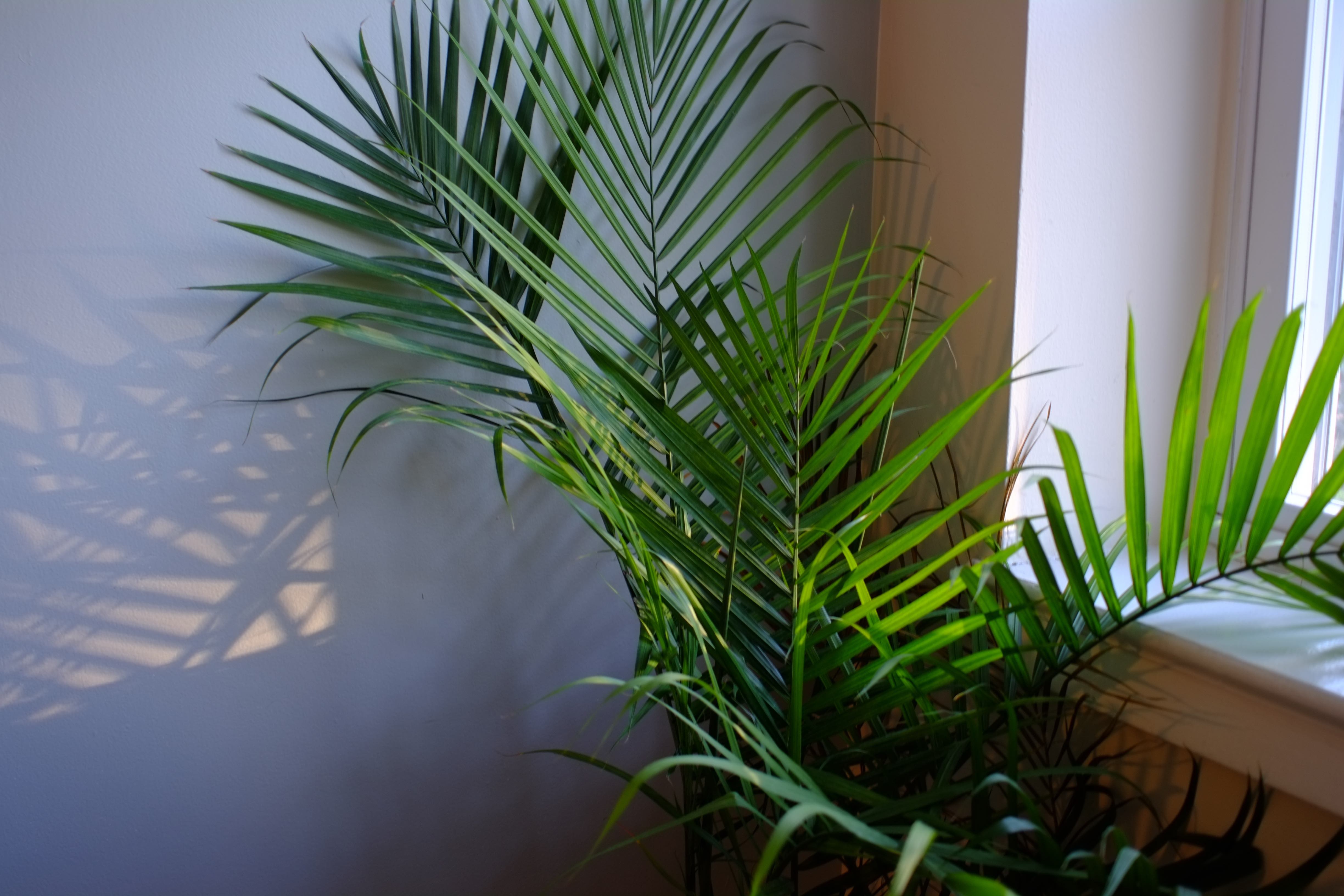
Last on our list of the types of palm trees in Africa is the majestic palm. The majestic palm goes by two other names: the Ravenea rivularis and the majesty palm. It is a type of palm tree with a maximum height of 98 feet in growth. The majesty palm has attractive long thin leaves with an upward arch. Because of this, the slow-growing palm tree became a well-known house plant.
You can only find these palm trees naturally in Madagascar, with only 900 of them surviving in the wild as of 2010. This is because the species grows within areas surrounded by deserts. This results in a limited spread of the species.
Majesty palms prefer hot semi-arid climates in southwest Madagascar. You can usually find them grouped together near lagoons, shallow swamps, and riverbanks. These isolated areas allow the majesty palms to gain sufficient water sources and humidity throughout the seasons.
The sensitivity of the majesty palm’s preferred climate makes it difficult to maintain at home. People with majesty palm houseplants must constantly provide moist and warm air for them to remain healthy. Failure to do so results in the majesty palm’s leaf tips turning brown. If you plan to own a majesty plant, you must also constantly water them during summer and spring and place them with fast-draining soil with containers built to drain water.
Types of Palm Trees in Asia
Asia is a vast continent filled with different cultures, climates, and environments. Each of these cultures has its own purposes for palm trees. That is why palm trees ranging from decorative to product-oriented have been cultivated in the area for centuries.
Livistona Chinensis
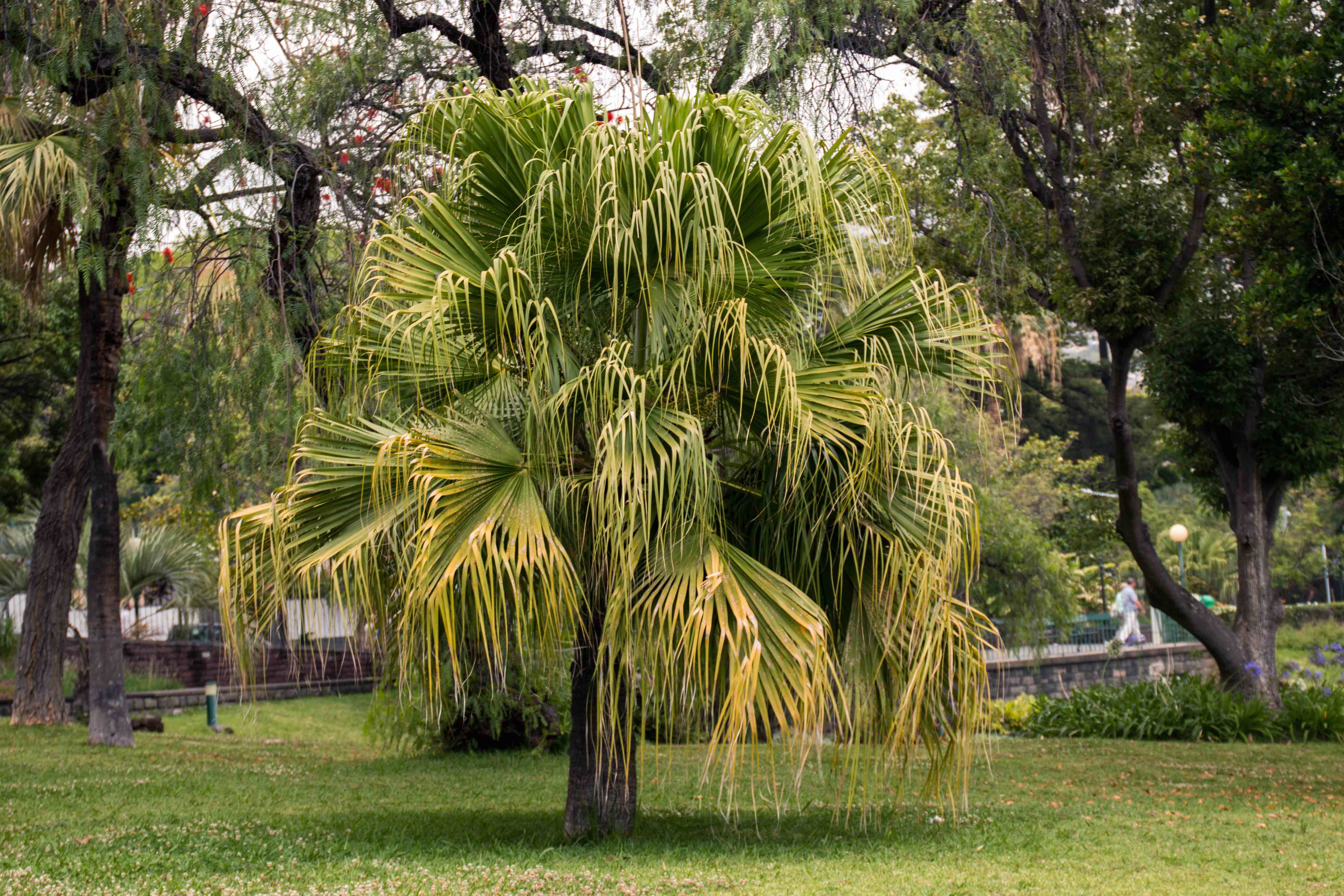
On our types of palm trees in Asia, we first discuss the livistona chinensis, also known as the Chinese fan palm. It is a popular type of palm tree used to decorate tropical regions around the world. Unfortunately, the cultivation of the Chinese fan palms has resulted in invasive effects on local environments. The Chinese fan palm creates large dense thickets which can take up space. It also produces large quantities of fruits and is quick to multiply. This results in an overwhelming number of Chinese fan palms affecting the natural habitats of areas where they do not belong.
The Chinese fan palm has an average height of 15 meters, with a maximum of 30 centimeters in diameter. They have palmate leaves with green or black spines. You can also spot their other characteristics, which include their pear-shaped fruits with colors ranging from blue-green to green and white or yellow flowers.
The Chinese fan palm prefers coastal forests with sandy soils in China. However, you can also find them outside of their origin country. Florida’s Chinese fan palms grow on hammocks and mesic woodlands. Reunion island has them spread across coastal areas, streambeds, and secondary forests. Bermuda island also has these fan palms growing by their roadsides.
Asian Palmyra Palm
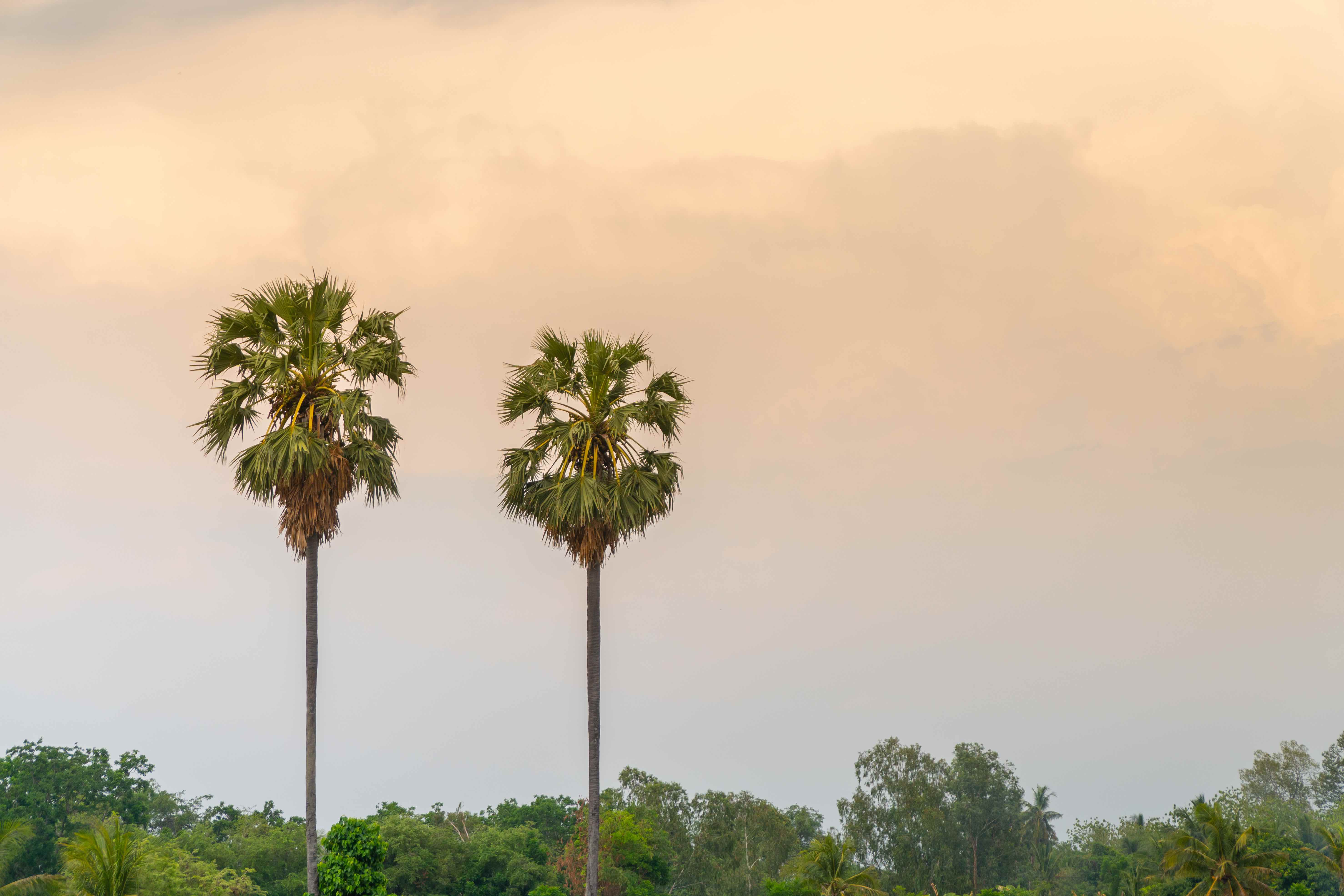
The Asian palmyra palm is one of the types of palm trees you can find in Cambodia. These types of palm trees are also called the tala palm, toddy palm, wine palm, doub palm, palmyra palm, and the ice apple. Asian palmyra palms have grey trunks and fan-shaped leaves. It has a maximum height of 98 feet and can create fruits with seeds growing 25 centimeters wide.
Asian palmyra palms are dioecious, meaning they can create male and female flowers. Their male flowers have similar features to catkin with their long body and semi-circular shape. The female flower is as small as a golf ball and remains solitary. The pollination of these two flowers creates the black or brown fruits of the toddy palm. These fruits taste sweet and have fibrous pulps which are a popular source of food production.
Cambodians have cultivated the Asian palmyra palm’s sap by tapping the top shoots then having a container (earthen pots, bamboo bottles, or plastic) collect the juice dripping from it. Thailand also used the sap of the palmyra palm as a source ingredient for sugar before welcoming sugarcane plantations. You can also harvest toddy from the young inflorescence of the palm tree. Toddy is a sugary sap that is fermented to create alcoholic beverages and other types of sugar.
There are other uses of the Asian palmyra aside from food consumption. Bengals use the Asian palmyra palm for religious practices. Lakshmi Puja, a Hindu festival, uses the white kernels of ripened Asian palmyra palm fruits as offerings. Manufacturers and locals also use the leaves of the Asian palmyra palm to create writing materials and household items.
Nipa Palm
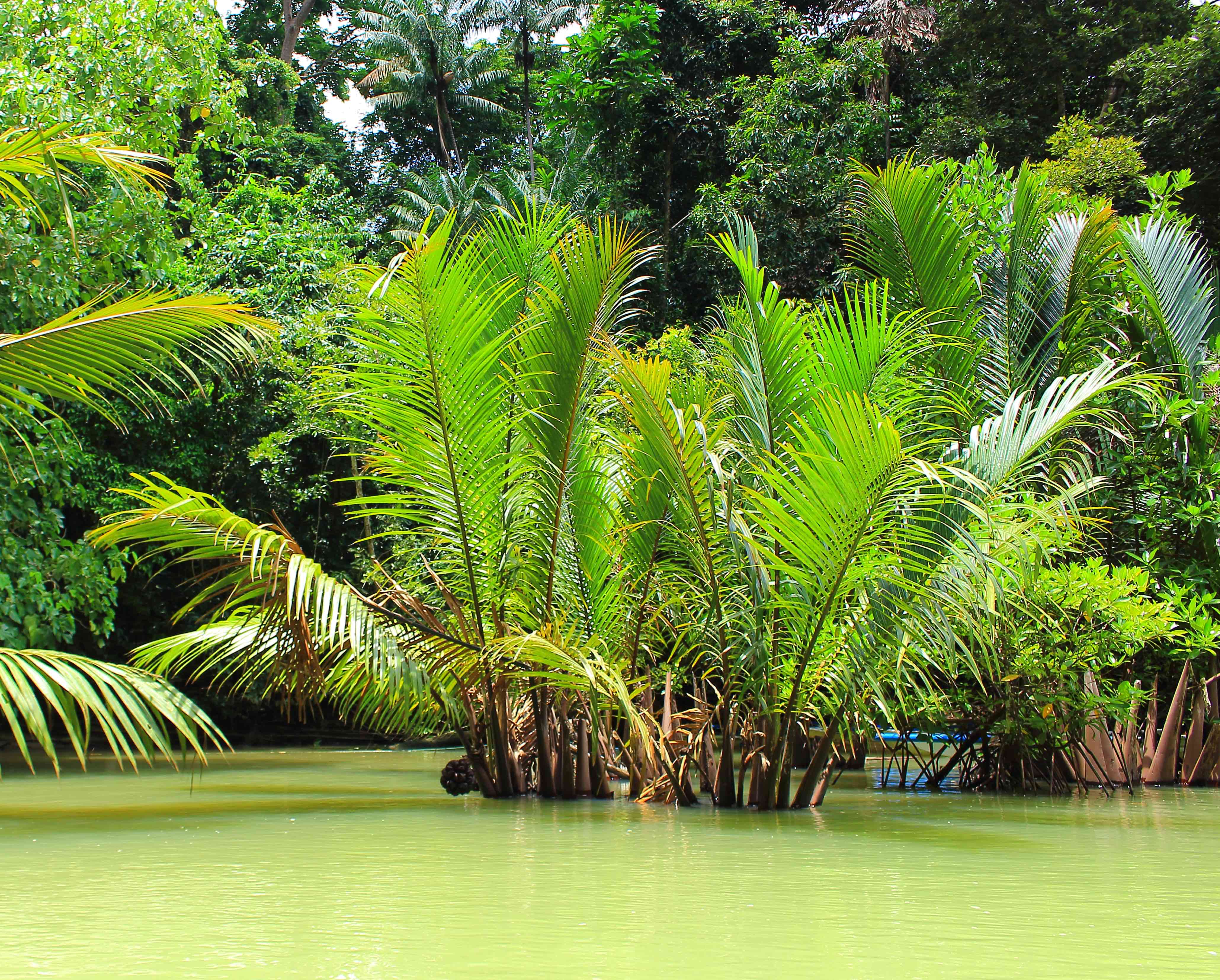
Next on the types of palm trees is the nipa palm, also known as the mangrove palm. You can find this type of palm tree in both the Pacific and Indian oceans. What makes the nipa palm unique is its ability to adapt to mangrove biomes.
Another interesting fact about the nipa palm trees is that their trunks grow underneath the soil. So if you were to see a nipa palm tree in person, you would only see the leaves and flower stalks. However, the leaves themselves are tall enough to reach 30 feet in height.
Nipa palms thrive in soft mud and calm moving waters. However, flowers of the nipa palm produce the ripened woody nuts that float along with the tides making germination further inland possible.
There are many Asian countries that use nipa palms in their daily lives. Nipa palm trees can be used to create cigarette papers, roof covers, baskets, and ornaments. But there are three unique ways Asians use nipa palm. The Burmese swim with the stems of the nipa palm tree. This is because the stems are buoyant, which creates a natural floater for practicing swimmers. The Roti and Savu islanders feed nipa palm sap to their pigs during hot weather. This allows the pig meat to have a sweeter flavor for consumption. Meanwhile, Filipinos and Malaysians create alcoholic beverages with the inflorescence of the nipa palm.
Chinese Windmill Palm
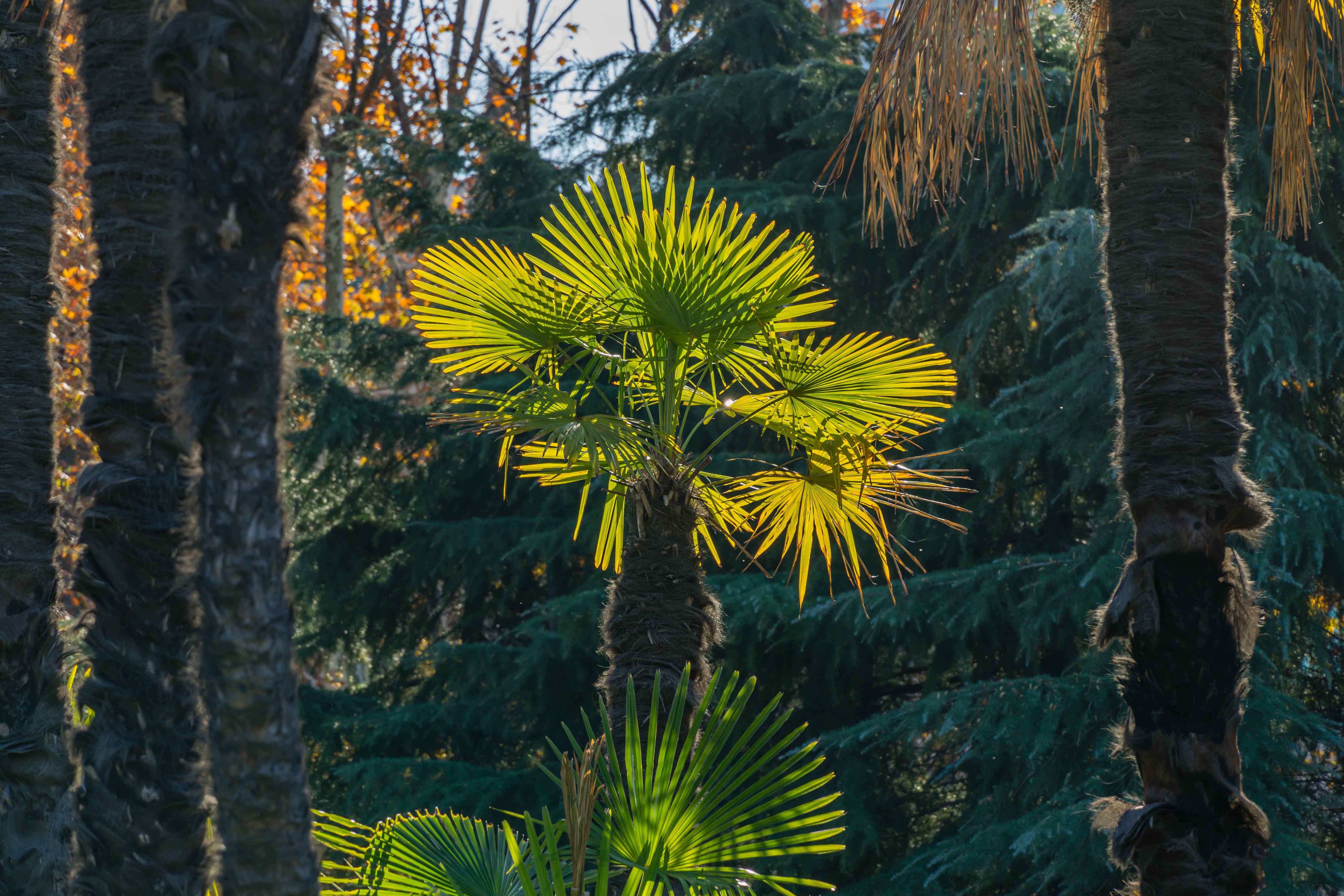
The trachycarpus fortunei, also known as the Chinese windmill palm or the chusan palm, is native in Myanmar, India, Japan, and China. It can stand as tall as 66 feet and produce evergreen fan palms with hardy and rough stems.
Just like other types of palm trees, the Chinese windmill palm has male and female flowers with yellow or green colors. Its fruit is a kidney-shaped drupe with yellow, blue, or black colors that ripen during the autumn season.
A mature windmill palm can tolerate temperatures of up to -4 degrees Fahrenheit. This is because the windmill palm’s ideal habitat is along the mountains of southern China, with cool summers and winters. As a result, European countries such as the UK, Poland, Germany, France, and Belgium have shown successful cultivation of the Chinese windmill palm tree.
It is important to note that the fruit of the windmill palm is inedible. However, there are more practical uses of the windmill palm. People use the Chinese windmill palm leaves to create woven baskets, coats, fans, and hats. You can also use the fibers coating the palm tree to make ropes, clothes, and brushes. However, it is more popularly used to frame entryways and gardens.
Date Palm
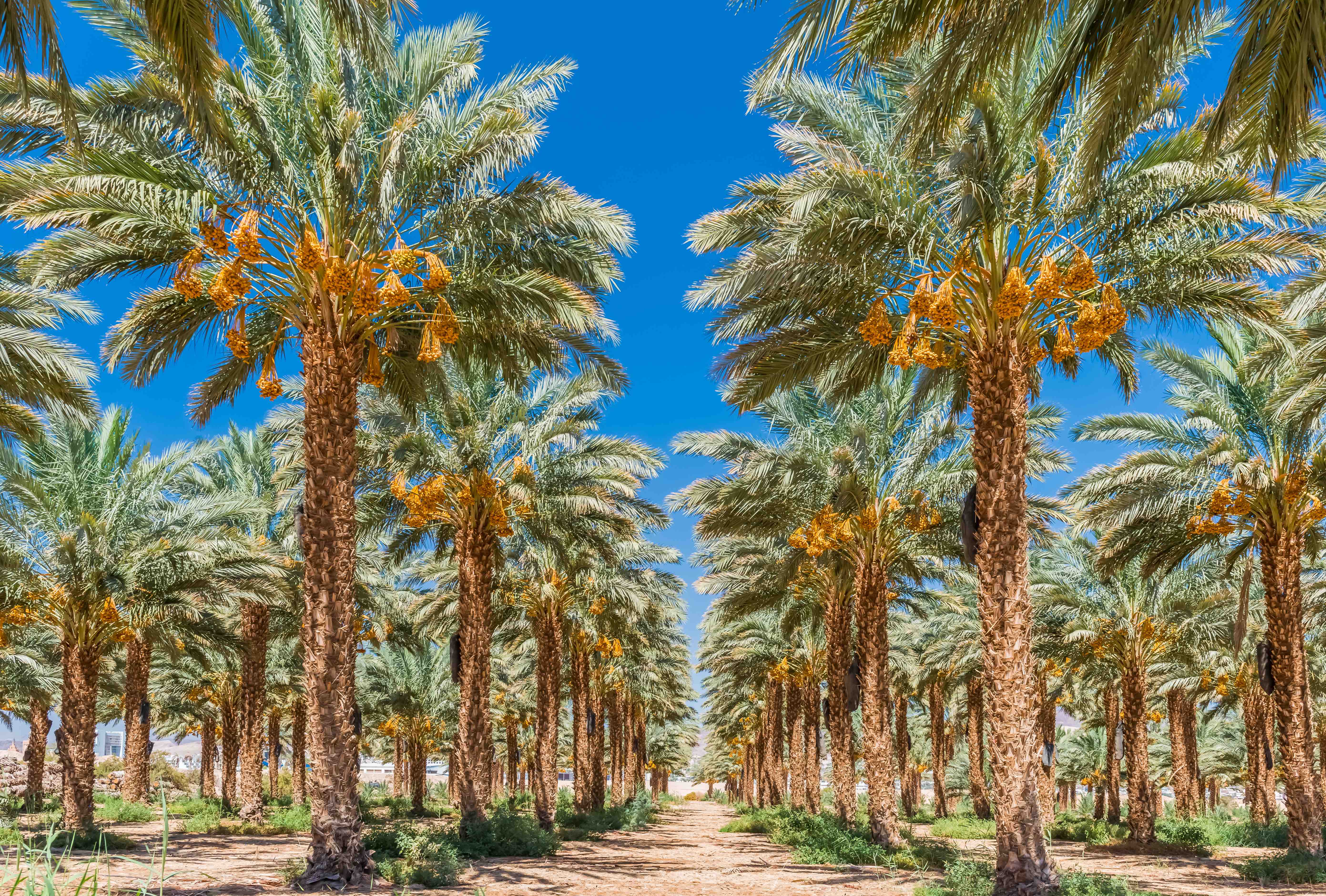
Date palms are one of the earliest types of palm trees around the world. These palm trees can reach a maximum height of 75 feet. The stem of the date palm is covered with pruned stubs and floral spikes from previous leaves.
Historically speaking, the fruit from the date palms has been a source of wealth and a staple food in both the Middle East and Africa. Nowadays, date palms grow in the Canary Islands, Mexico, California, Pakistan, the Middle East, and India. However, the countries leading date production and exports today are Saudi Arabia, Iran, Egypt, and Iraq.
Date palm trees have high economic value because of the many items that are made from their materials. In terms of food, the date fruits are used to create alcohol, beverages, and desserts. There also are drinks made from the date palm sap. You can even make a salad out of the terminal bud of a date palm tree that has been cut down.
Manufacturers also find value in the date palm tree. This is because the timber and the leaves are good supply materials for furniture and crates. Its fiber is also perfect for creating packing materials and cordages.
While the date palm can last up to 150 years, plantations quickly replace older date palms for younger ones. This is because an older date palm will usually regrow fruits longer compared to newer ones.
Types of Palm Trees in Oceania
Different kinds of palm trees thrive in Oceania because of the perfect weather conditions and nutrients in the area. Islands that have little forestry rely on palm trees as a substitute for building materials and shelter. This results in numerous palm trees being mass-produced.
Nikau Palm Tree
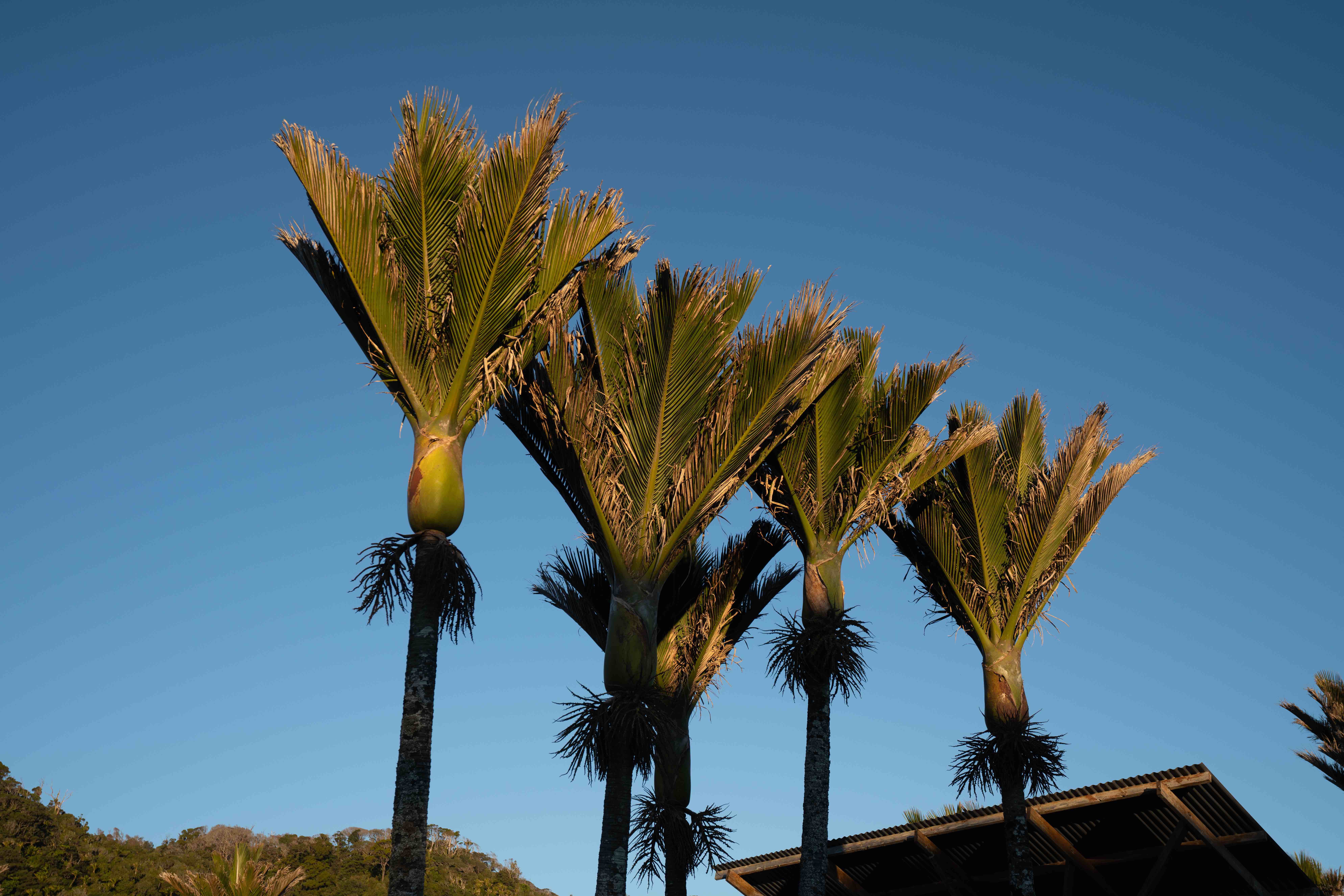
Rhopalostylis sapida, also known as the nikau palm tree, is endemic to New Zealand. It is named after a Maori word, which refers to the midrib and the fronds of the coconut palm tree. The nikau palm can reach a height of 15 meters. It possesses a plump green trunk that is covered in grey to green scars from leaves. The crownshaft of a nikau palm can grow up to 1 meter long and its fronds reach up to 3 meters in length.
The flowers of the nikau palm tree can be both male or female with lilac to pink colors. The difference between the two flowers is that male flowers are in pairs while female flowers are solitary.
Nikau palms grow well in cool temperatures. However, Nikau palms are sensitive to freezing temperatures. This is because the nikau palm’s natural habitat is between coastal areas and lowland forests.
The Maori use the nikau palm for their cooking. The leaves of the nikau, in particular, are used to wrap food. The Maori also consume the younger leaves and flower clusters, both raw or cooked. Old fibrous leaves are also useful for the Maori as floor mats, thatch, and kete.
You can keep a nikau palm at home. This is because nikau palm trees are hardy, slow-growing, and can be sprouted easily through the use of plastic bags or soaking the fruit in water for days. You should make sure the pots are tall and narrow enough for the nikau palms’ taproot if you plan to transplant the palm eventually.
Fiji Fan Palm
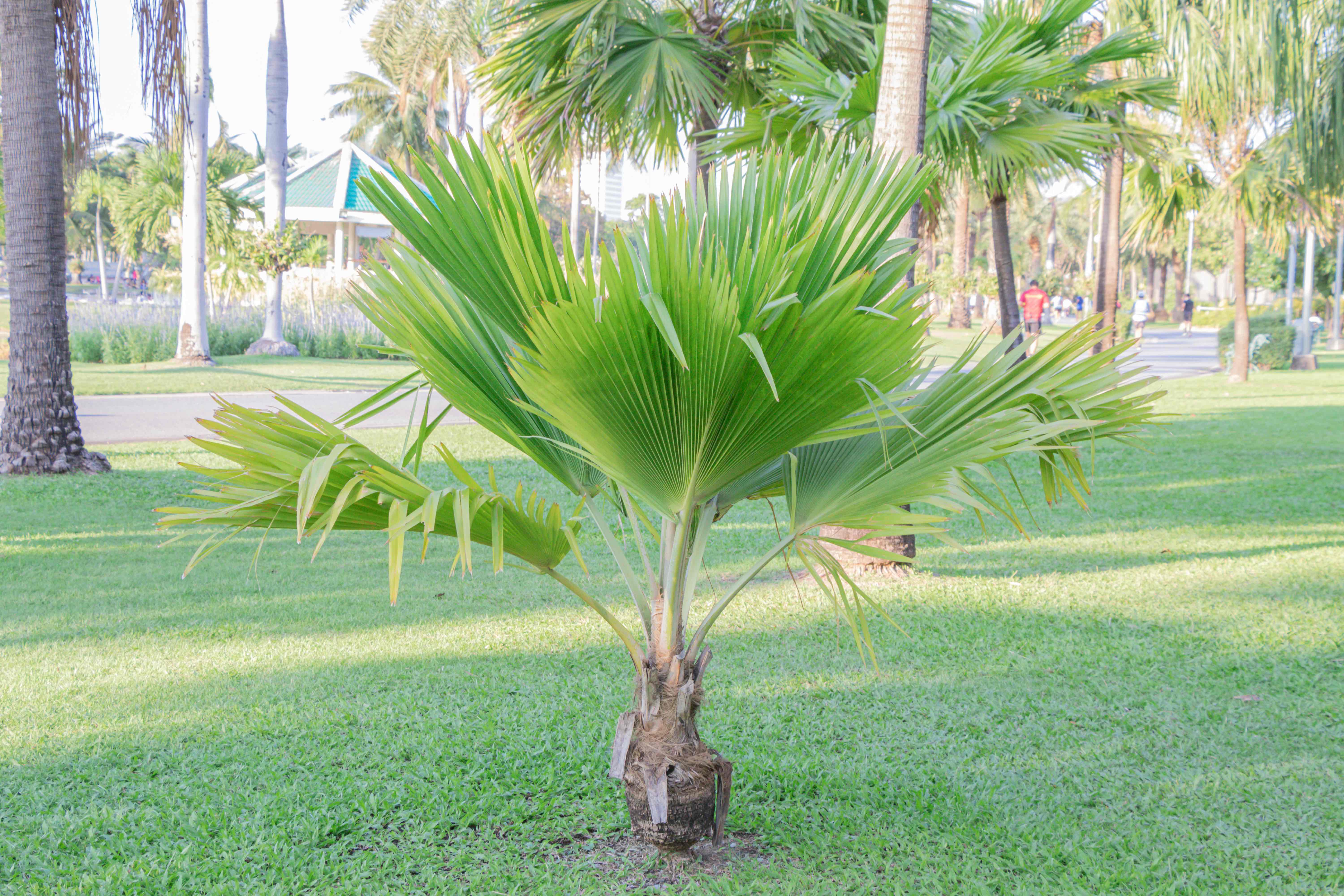
The Fiji Fan Palm tree, also known as the Pritchardia pacifica, is native to Fiji island. The maximum height of the Fiji fan palm is 20 feet and it could grow 10 feet wide. Its crown is filled with 15 to 20 fronds. It has a straight trunk with a smooth texture and is 20 inches in diameter. Fiji fan palms have fan-shaped green leaves 7 feet in length and 6 feet wide. They also have brown fragrant flowers that grow in between the leaves and can produce spherical fruits that turn green, red, and then black once ripe.
Many people opt to take care of a Fiji fan palm because of its leaf patterns. The Fiji fan palm’s seed germinates after 30 days. Maintenance of a Fiji fan palm is easy. It only requires partial sunlight and moderate water consumption. We can prevent nutritional deficiency by using quality palm fertilizer.
Originally the chiefs of Fiji used the fan palm leaves as fans and protection from sun and rain. They also used the trunks of the Fiji fan palm to create ridge beams. Nowadays, the Fiji fan palm is purely ornamental and raised by gardeners and palm enthusiasts.
Fiji Island Dwarf Coconut Palm
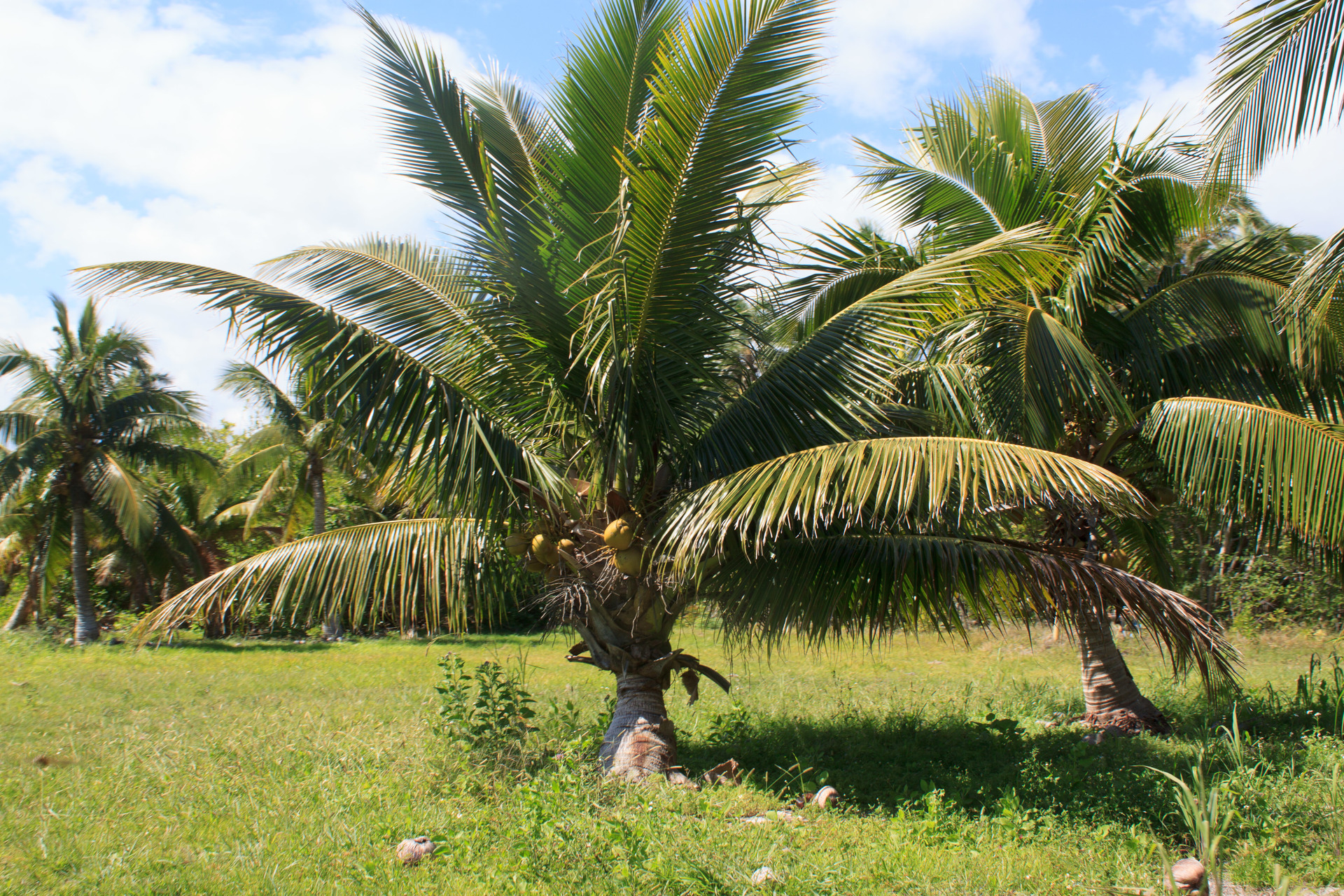
The Fiji Island Dwarf belongs to the Dwarf Coconut Palm family, which houses other palm trees like the Cayman Mahafee. Dwarf coconut palms reach a maximum of 30 feet. However, the dwarf palms eventually grow to reach 16 feet in height. The Fiji island dwarf lives up to 40 to 50 years just like most dwarf palm trees. If you compare it to other types of palm trees, this is a relatively short lifespan.
Also known as the Niu Leka, the Fiji island dwarf possesses long leaflets, small coconuts, and bronze-colored leaf ring scars. You can conveniently harvest the coconuts without a ladder since the tree can bear coconut fruits after recently sprouting. However, the Fiji island dwarf doesn’t remain small. It eventually grows rapidly at around 1 foot a year.
Dwarf palm trees like the Fiji island dwarf can self-pollinate. This is because both female and male phases for the Fiji island dwarf overlap in the same inflorescence. However, it is also possible to cultivate the Fiji island dwarf by cross-pollinating with other tall palm tree varieties.
The Fiji island dwarf became popular in Florida after resident coconut trees were struck with lethal yellowing phytoplasma. The Division of Forestry in Florida proposed to replace the tall palm trees with dwarf types such as the Fiji island dwarf. This is because the Fiji island dwarf is extremely resistant to diseases and ornamental beauty. Additionally, the Fiji island dwarf has no nutritional deficiency that other Florida palm trees are infected with.
Licuala Grandis
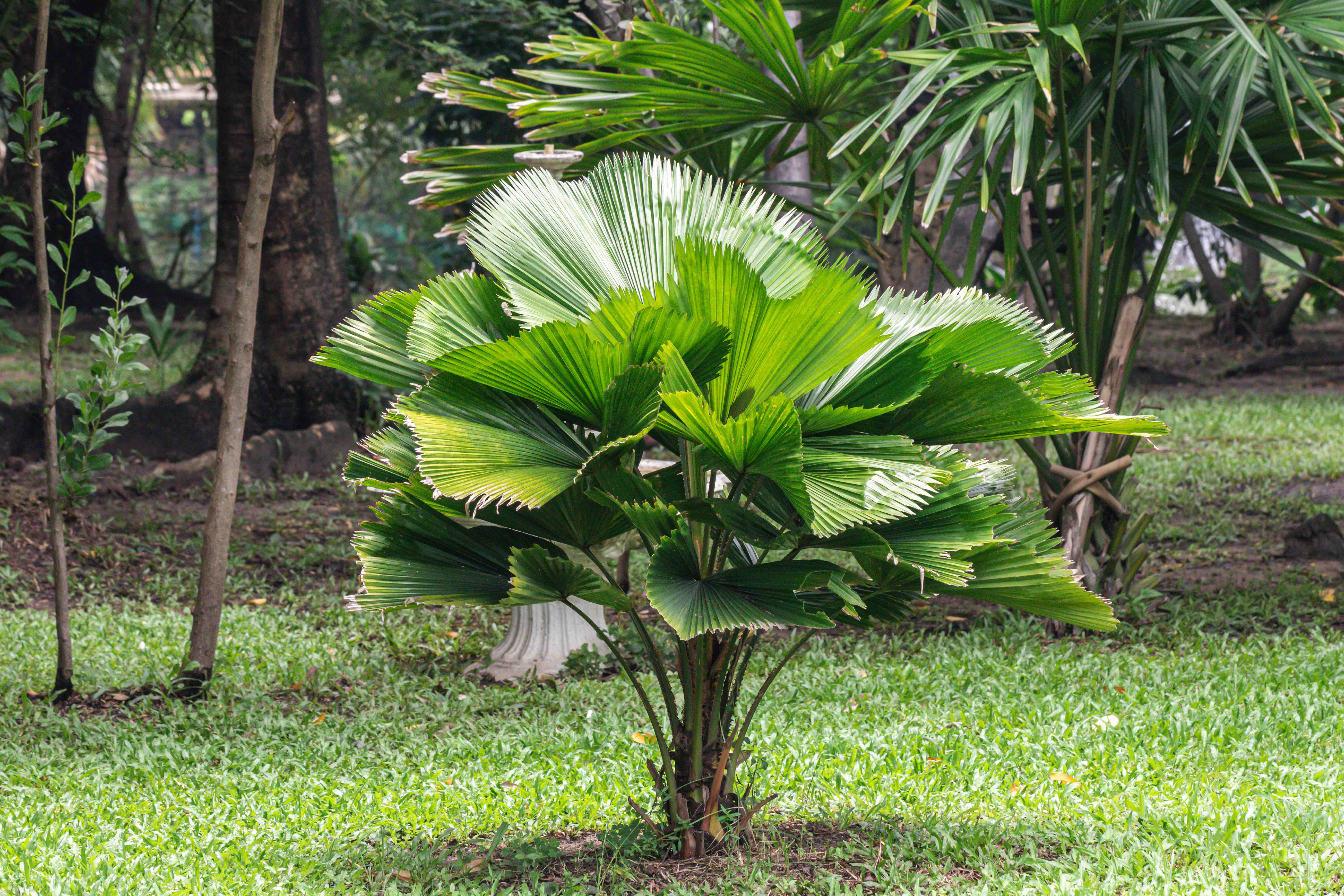
The licuala grandis, also known as the Grosse licuala palm, Vanuatu fan palm, or the ruffled fan palm, is part of the Arecaceae genus. It is one of the types of palm trees that are native to the Solomon Islands and Vanuatu region, which are tropical climates.
Just like other palm trees, the licuala grandis can produce flowering seed plants. The male and female flowers of the licuala grandis are bisexual, white, and sprout from the inflorescence in between its leaves. Licuala grandis have marble-shaped and glossy fruits that change color from green to red when ripened.
Since they come from a tropical climate, the licuala grandis prefer shaded areas. As a rainforest palm tree, it needs to be protected from storms filled with heavy rains and strong winds. Additionally, the licuala grandis is also weak against aerosol salt. This means that the licuala grandis is not suitable for coastal areas. These palm trees require fertile soils between acidic, neutral, slightly alkaline, or clayey as long as the soil is drained.
The umbrella-sized leaves of the licuala grandis were used for thatching. Nowadays, people prefer taking care of the licuala grandis because of its adaptability to live in containers. You can plant them in well-drained soils in both indoor and outdoor areas.
Molokai Fan Palm
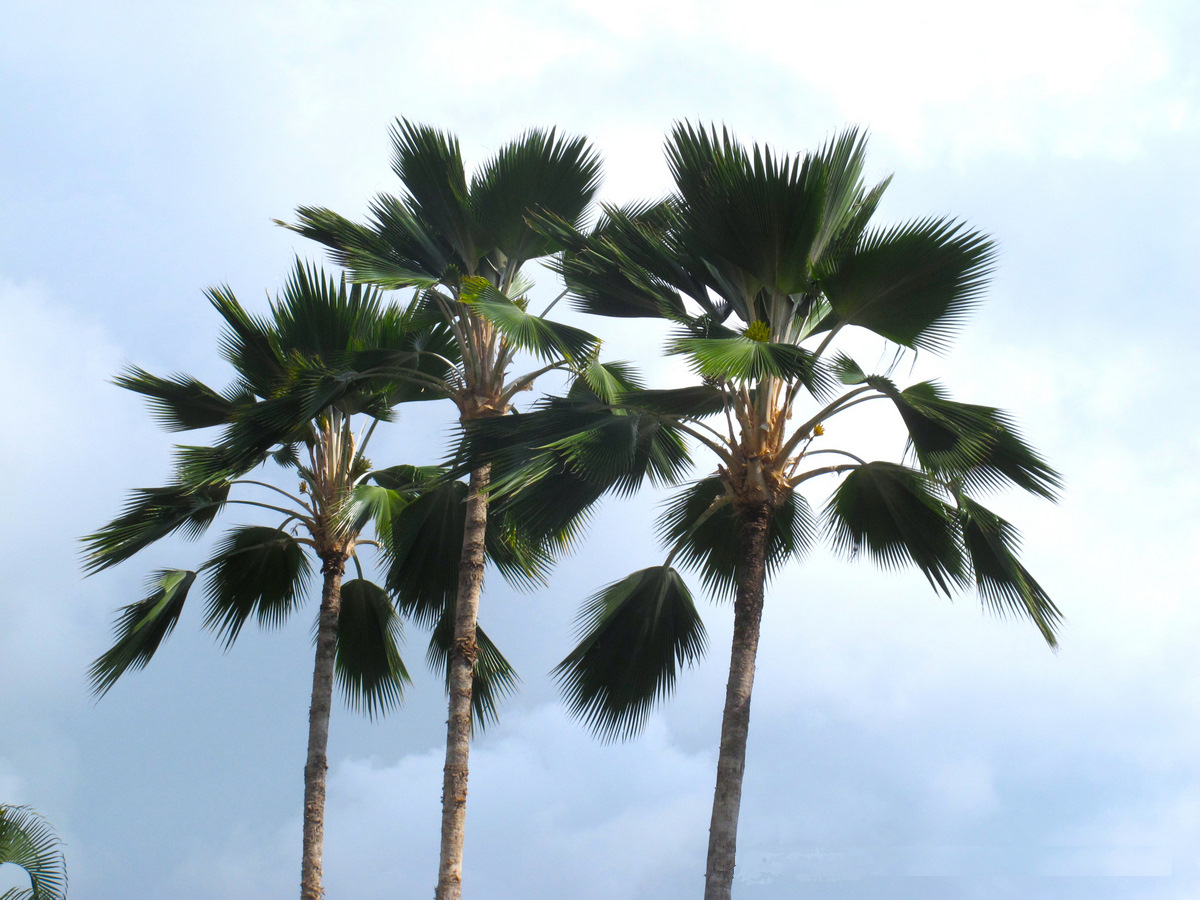
The Molokai fan palm is one of the types of palm trees endemic only to the island of Molokai. You can find them in the northeastern coastline around elevations of 100 to 1,900 feet in the islets of Huelo and Mokapa. Hawaiians call the Molokai fan palm the loulu lelo.
Molokai fan palms have fan-shaped leaves with silvery undersides. They produce golden flowers with black spherical fruits the size of a marble. These fruits taste like coconut and are consumed after being peeled.
Hawaiians used Molokai fan palm seeds as a source of food during the early years of their civilization. They also used fronds to weave hats, the trunks as building materials, and the leaves for thatching, umbrellas, and activities like cliff jumping.
Molokai fan palms are endangered. You can find the last forest of Molokai fan palms off the Molokai coast surrounded by water. The water protects the Molokai fan palm forest from wildlife, such as rats, pigs, and goats that prey on the delicious seeds of the palm trees.
W.S. Merwin’s Garden is a conservatory for wildlife and arts in Maui. They named it after poet W.S. Merwin, who found joy in planting palm trees. Because of the rarity of the Molokai fan palms, there are currently only four Molokai fan palms growing in the Merwin Palm Forest.
Types of Palm Trees in Australia
Australia is also a part of Oceania. However, it is also big enough to be its own continent. It has a wide variety of tropical climate palm trees that spread around the entire area. There are even palm trees endemic only to the continent.
Foxtail Palm
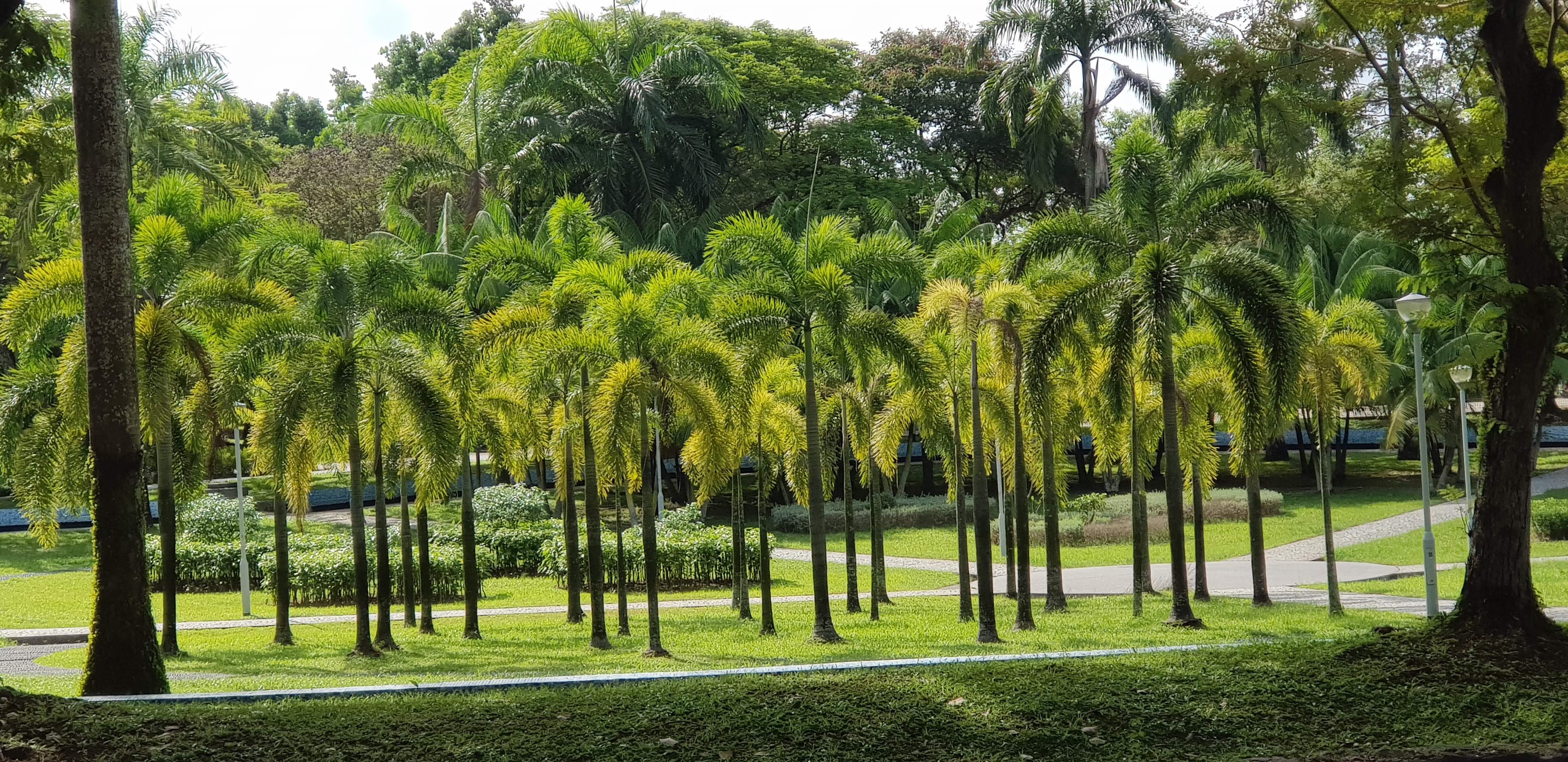
The foxtail palm tree, also known as the Wodyetia palm, is one of the most popular types of palm trees around the world. This is because of their beautiful foliage displays, durability against high winds, and impressive tolerance to soil conditions ranging from limestone soils to rocky sands.
Foxtail palm trees have a self-cleaning slender trunk with colors ranging from dark to light grey. They have smooth green crownshafts that bear a resemblance to the tail of a fox (hence the name). Its unique leaves grow up to 10 feet long and create feather-like fronds. It’s a fast-growing plant with a maximum height of 30 feet and 10 feet in width.
The flowers of the foxtail palm are branched flowers with creamy inflorescence. You can find them at the base of the foxtail palm’s crownshaft. With both male and female flowers growing on it, there is a cluster of oval fruits that turn red or orange-red once ripe. However, it is important to note that the fruits of a foxtail palm are poisonous to humans and the seeds can kill pets.
Unlike other types of palm trees, the foxtail palm tree is a recent discovery. An aboriginal man named Wodyeti introduced the palm tree to botanists in 1978. In honor of Wodyeti, they named the foxtail palm genus after him. Foxtail palms are adaptable for both indoor and outdoor use. It requires partial shade with moderate watering and well-drained soil.
Bangalow Palm
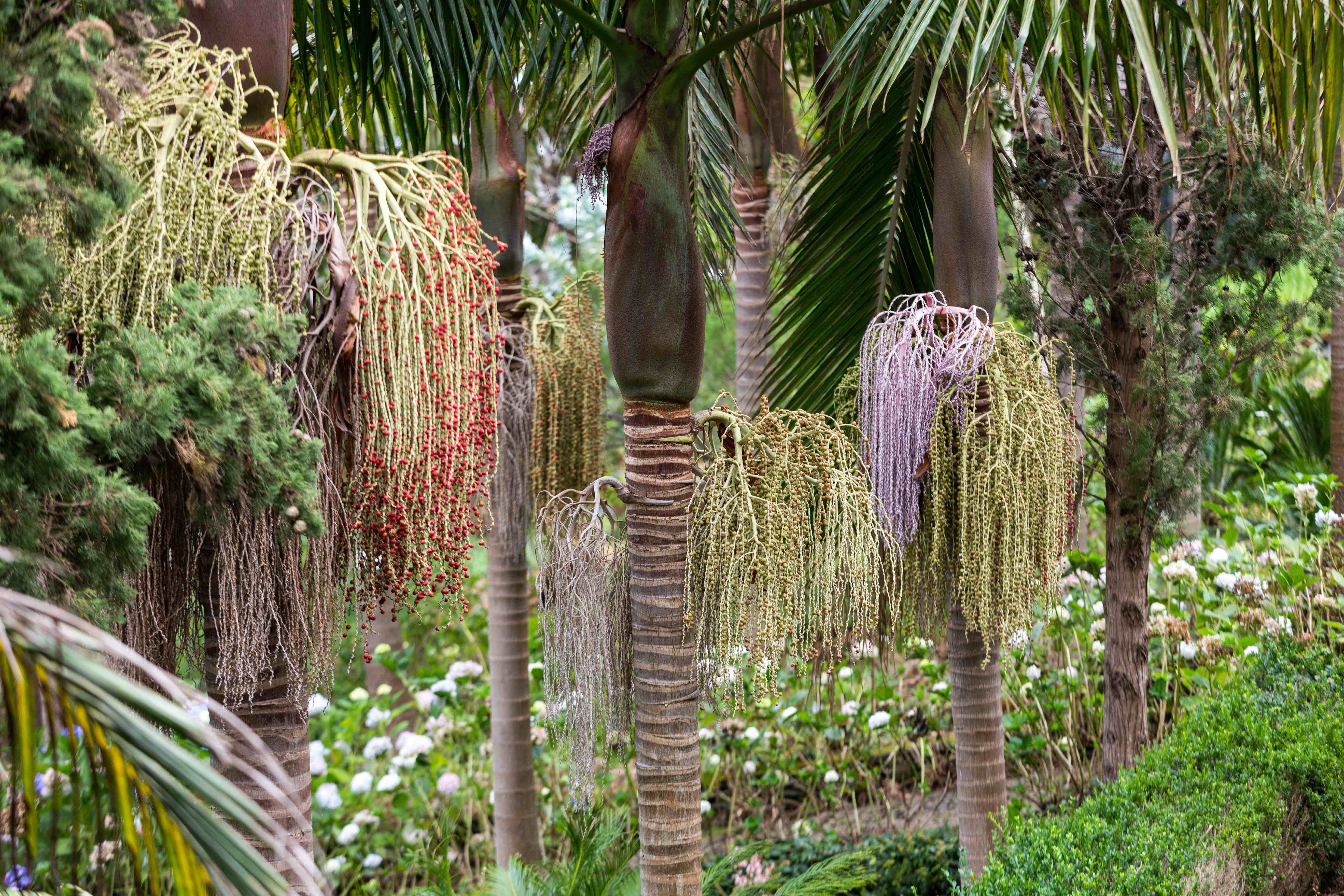
The common names of the Archontophoenix cunninghamiana are the Bangalow palm, king palm, and Illawarra palm. This Australian palm tree has a maximum height of 30 meters with violet flowers, evergreen foliage, and red fruits which attract birds.
You can find Bangalow palms in the wet subtropics of Mt. Warning Volcano and Lamington National Park borders. This is because the Bangalow palm prefers consistent water supplies such as ravines or grottos.
Botanists declared that the land bridge from 45,000 years ago allowed the Bangalow palm to exist in Australia. This is because they believe its original habitat before Australia was in Indonesia.
Modern uses of the Bangalow palm have been purely ornamental. Urban developments use the tree to design cities because of its inability to create nesting environments for rodents. However, there are areas that consider the Bangalow palm as an invasive species. An example of these areas in southern Brazil, which has invaded the area since the local extinction of their endemic palm tree, the Euterpe edulis, The Bangalow palm is also a threat to the nikau palm of New Zealand. This is because they have the same ecological requirements, but the Bangalow palm has noxious weed traits.
Aboriginal people traditionally used the bases of the Bangalow palm to carry water. That is why it was named Bangalow since it is the Aboriginal translation for the words water carrier. Early settlers and the Aboriginal folks also ate the shoot and cabbage-like leaves.
Macarthur Palm
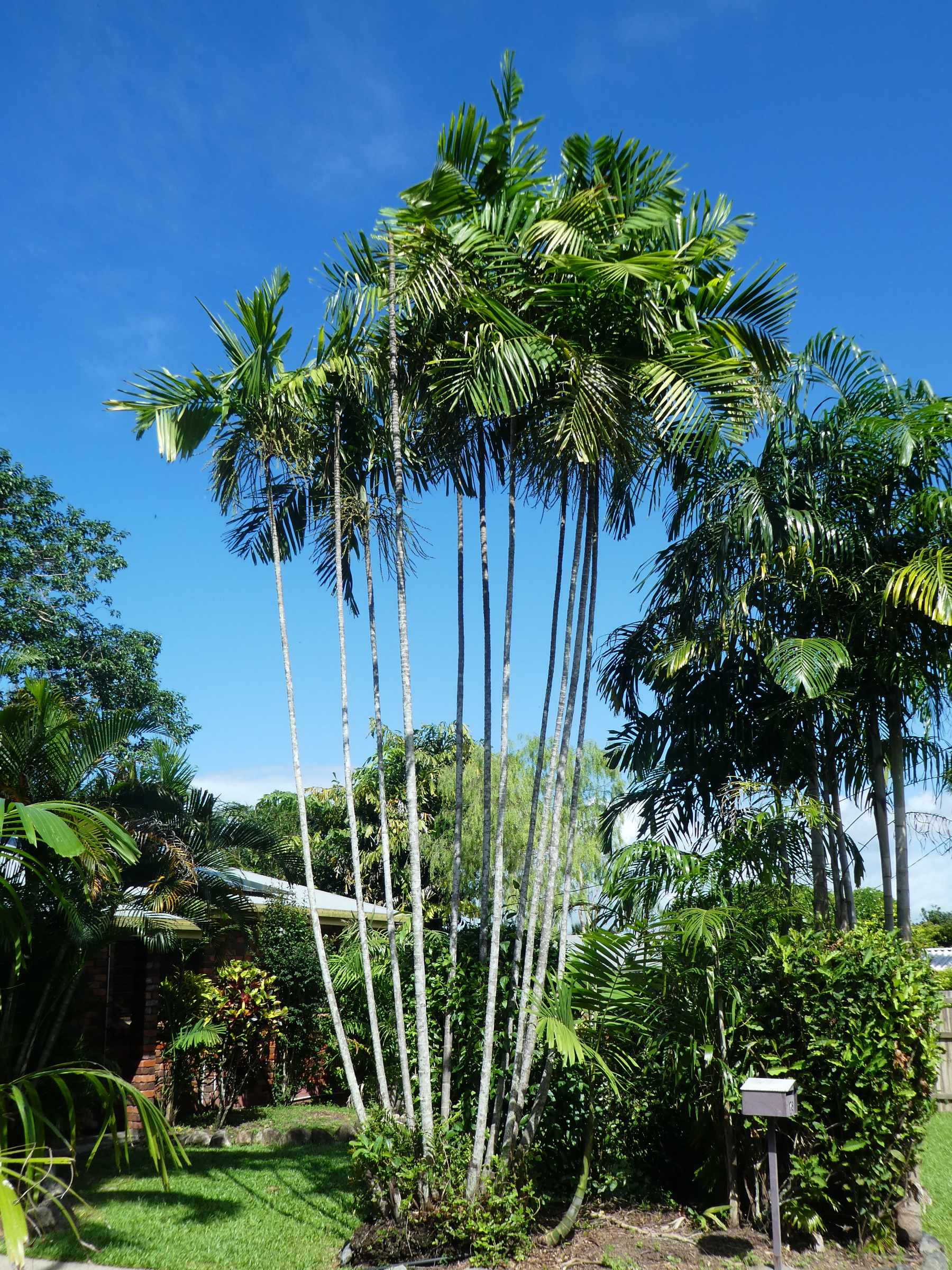
The Macarthur palm is one of the types of palm trees endemic to Australia and New Guinea. You can find a wide range of Macarthur palms in the Cape York Peninsula, Queensland where they join grazing wildlife and untouched lands.
Macarthur palm trees can reach a maximum height of 33 feet with slender stems. It produces one female flower between two male flowers that have yellow-green to light-green colors. The Macarthur palm tree produces ripened fruits in bright red colors that possess a thin protective layer around its one seed.
You can also find a small cluster of endangered Macarthur palm trees in the Northern Territory of Australia. However, the limited distribution of the Macarthur palm in the Northern Territory remains unlisted on the IUCN Red List as of 2021.
Thomas Reedy was sponsored by Sir William Macarthur, a famed horticulturist, during the Chever Expedition of 1875. It was in this expedition that Thomas Reedy studied the palm tree’s properties from a specimen collected from the area. Sir William Macarthur forwarded the description along with the specimen to the Veitch Nurseries of England. It was Harry Veitch, head of the Veitch Nurseries, who instructed it to be named after Sir Macarthur.
Alexandra Palm
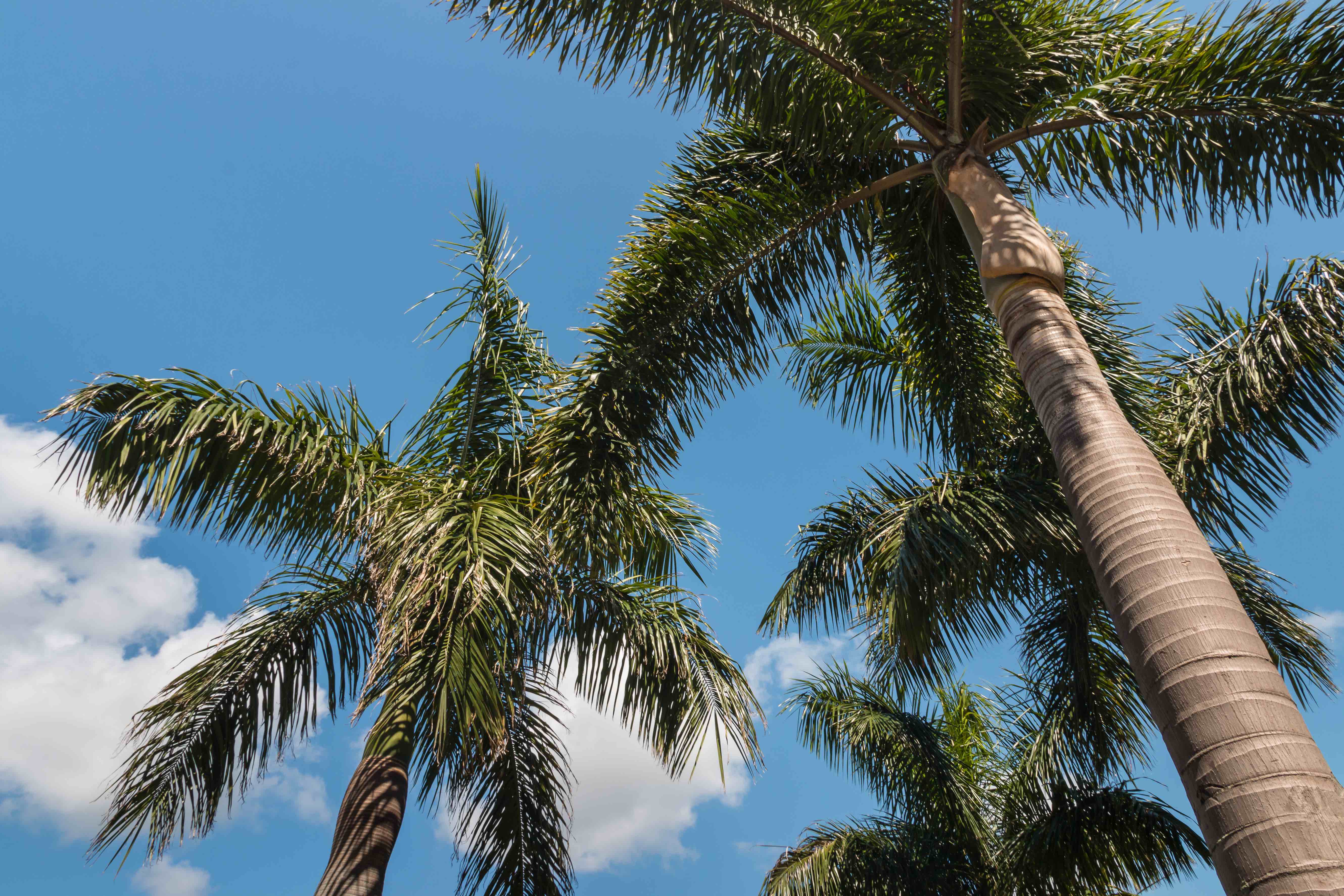
Last on our list of the types of palm trees is the Alexandra palm of Queensland, Australia. Archontophoenix alexandrae, also known as the Alexandra palm, king palm, Northern Bangalow palm, or the feather palm, is named after the Princess Alexandra of Denmark. It is a solitary palm tree with a maximum height of 98 feet with a swollen base and prominent leaf scars. It possesses a crown with feather-like fronds and leaves that have dark green and silver-grey colors which are attached to a light green crownshaft.
You can find the Alexandra palm in Queensland around the Melville Range to Gladstone. It thrives in rainforests beside rivers and swamps that experience large amounts of heavy rain. This results in the Alexandra palm becoming a dominant species in the area.
Alexandra palm trees have creamy white inflorescence that develops a light green color when producing fruits. The fruits themselves change from green to bright red when ripened. Once the fruits are ripe, the Alexandra palm sheds its brown inflorescence.
Birds such as the Metallic starling, the Torresian imperial pigeon, and the Wompoo fruit dove consume the fruits of the Alexandra palm tree for nourishment. Some Aboriginal Australians such as the Kuku Yalanji consume the palm heart of the Alexandra tree as well.
Modern cities prefer cultivating the Alexandra tree for ornamental purposes for their parks and private gardens. This is because the fast-growing tree has a moderate ability to withstand cooling temperatures. The Alexandra palm has been naturalized in Hawaii.
Conclusion
We hope you enjoyed learning about the types of palm trees listed here. The best part is that we only discussed 25 types of palm trees, meaning there is more for you to discover. Palm trees are a necessity, with benefits for all living creatures. Animals and indigenous tribes use them as a source of food and shelter, while industries use them for cooking oil and mass production of native goods.
Many types of palm trees are becoming endangered because of the growing demand for goods made with them. This affects us not only economically, but threatens the very livelihood of those dependent on palm trees. While looking for Florida palm trees may be a nice way to spend your retirement, it is best not to overuse their produce. We should always remember to take care of them and ensure that if we cut down one palm tree, we replace it with another. This will help both the environment, ensure the survival of many endangered animals and the palm trees themselves.
Was this page helpful?
Our commitment to delivering trustworthy and engaging content is at the heart of what we do. Each fact on our site is contributed by real users like you, bringing a wealth of diverse insights and information. To ensure the highest standards of accuracy and reliability, our dedicated editors meticulously review each submission. This process guarantees that the facts we share are not only fascinating but also credible. Trust in our commitment to quality and authenticity as you explore and learn with us.
